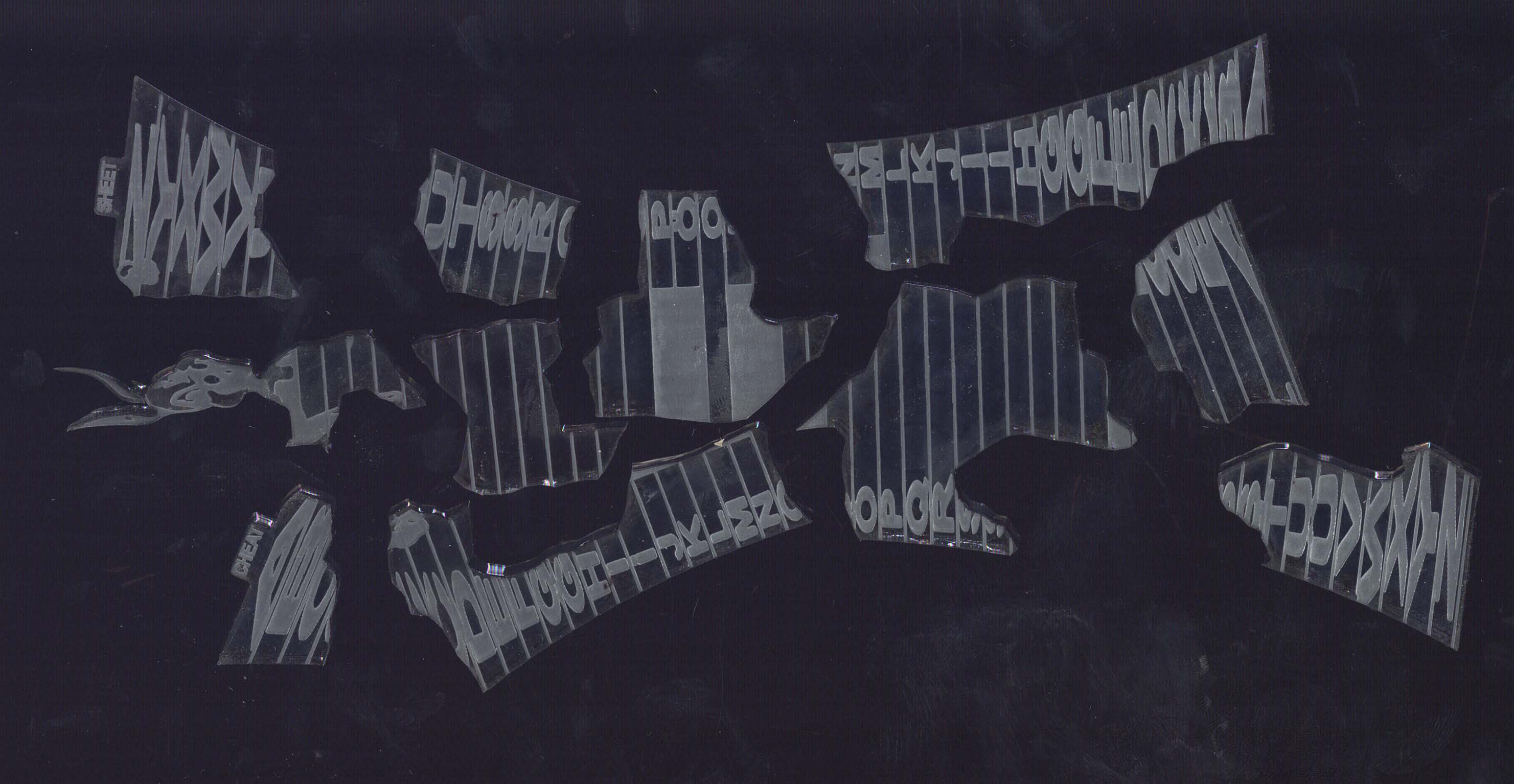
Abstract
Throughout history humankind, from nomadic times to contemporary societies, has strived to leave some kind of an indelible mark. Such a mark could vary from contemporary deforestation to prehistoric cave drawings—yet the main aim has ultimately revealed itself: to conquer.
In recent years, this ideology has translated itself into a new wave of absurd sculptures associated with corruption that can be found all over Turkey. As such, this thesis is focused on two parallel case-studies: the first concerns the sculptures I call ‘Political Talismans,’ while the second one is ‘ÇLMVÜİOZMV ÜFİZHQZ’ in Ankara currently the world’s largest abandoned theme park. I investigate these two topics as a new artistic movement while identifying overlapping points in terms of their unique aesthetics with ‘bootlegs, heterotopias and plastic modernity.’ In the nature of this so-called movement, artists are no longer being commissioned to produce works—instead the sculptures are just being bought from decoration hangars. Although society believes that they are the ‘bleeding open wound of our country,’1 I find them quite beautiful and worth investigating. Those works do not deserve to be demolished by the cringe-and-destroy culture, and their appearance is actually not so uncommon. We may find something similar in any thrift-store or spot them in low budget entertainment centres/restaurants or in the backyard of hoarders. But what makes them a new aesthetic form and makes them unique is their relation to the government.
The thesis follows a rascal approach while investigating the ‘childish’ obsessions and corrupt behaviour of a (few) (remarkable) politicians and the artefacts that they leave behind, as well as their effects on society. The analysis is mainly based on my observations over the years I lived in Turkey coupled with archival findings, associations, fictional writings and interviews with production companies. Despite the fact that it is a very recent development, not much analysis has been done about them, an aspect which motivates me to inquire if any connections have not yet been discovered. The stories and reasons behind this fantasy-oriented irrational approach to public space have led me to several questions: How does a capitalist, state-funded, absurdist art movement, become the unintended visual language of corruption? What are the reasons for the exponential growth of this movement? Are they just reference points used for spatial orientation, or is it a presence game that is being played with public funds?
1News titles from various digital web sources.
Chapter 1: Meeting With The Absurd

For the average person, there is a meaning in life and that is mainly to graduate from a well-known school and to finally wear a suit and tie, holding their briefcase on their way to the office everyday. I saw the ambition for this profile throughout my academic career. Everyone seemingly had one goal in life, and it was this. What I wonder is that if these people will ever fall into the trap of meaninglessness, or are sanity-controller systems like social media not allowing them to fall into any kind of trap like this concept which would provide digital happiness and a utopia?
Mostly whoever told me about the meaninglessness of the world, they were primarily bothered by it and it was a form of depression. These people just could not understand the beauty of it. If I was also one, that would probably lead to a tragic end for me as well (laughs). It is really interesting how the same kind of world-view has had different effects on human beings. Thinking about it, perhaps the part that led me to acknowledge the beauty of the absurd was a passion for creation. As I created, I could therefore reflect. ”If the world were clear, art would not exist”2 therefore I could just draw or paint or puke a meaningless world and make my own meaningless approach on it as everything in nature, history and life is nothing more than a cycle of loops. But, the one that had the dreams of becoming a corporate man, sadly finds himself in the depths of the hole once the absurd rings his bell. As this person never had the chance to create, to fantasise and to live in their own parallel universe, they never could find the time to even meet with the absurd, not even to talk of tricking them..
“…the gap between the wealth of visual experience in contemporary culture and the ability to analyse that observation marks both the opportunity and the need for visual culture as a field of study.” 3 ‘NÜOQŞ TKÖWÜÖ’4, a man with crazy dreams and fantasies almost bordering on fetishism, transformed into a bodily living corporate. A part of the corrupt governmental system, ‘NÜOQŞ’ finds his way by “dancing” with this absurdity—he loves his suit and tie and his working environment, from the offices to the parliament. He never falls into the trap because quite systematically, with the power derived from his job, he can build his dream-like world. ‘NÜOQŞ’ thus becomes the leader of absurd himself because he knows how to trick it— perhaps this stems from ignorance and the dizzy haze that power brings with it. While the whole of society hates on his moves and activities, I am quite fascinated by them and find myself questioning their effects and necessity. A corrupt government can only be represented by their brave individuals. He is a great mirror, a great example of the era we are living in terms of reflecting the ideology espoused by the government: to conquer! To conquer people’s minds (propaganda, brainwashing), their eyes (sculptures and any kind of public appearance) their houses (minority groups, and TOKI urban transformation projects), their money (undefinable taxes), their belongings, and their loved ones (jails). With the current government, this ideology of conquering finds a new way of bodily living it is not perfectly sculpted one-to-one black stone monuments of questionable or unquestionable people itis a whole new level that is unlocked. This level carries out more responsibilities as it ignores any kind of pre-existing constructions and rules. ‘NÜOQŞ’ was aware we needed something new, and corresponding to my childhood feelings, he knew he had childhood dreams and fantasies and what else to do in this meaningless world than spending the national treasure on huge sculptures/theme parks? ➙A☎



Images: Sculpture from a production company (1), My childhood photos side-by-side with (2,3,4) ‘NÜOQŞ’ 2: Camus, Albert. The Myth of Sisyphus, and Other Essays. A.A. Knopf, 1964. 3: Mirzoeff, N. (1998). What Is Visual Culture? In N. Mirzoeff (Ed.), The Visual Culture Reader. essay, Routledge. 4: Former mayor of Ankara 5: Mirzoeff, N. (1998). What Is Visual Culture? In N. Mirzoeff (Ed.), The Visual Culture Reader. essay, Routledge.

➙A☎: At the end of the day, the aim is to break the norms and become someone remarkable. “It is that edge, that buzz that separates the remarkable from the humdrum.”5 says Mirzoeff, talking about the impact of visual imagery rather than written text. The rhetoric skills are getting harder and harder to stabilise as they mostly rely on written text and prompters. Above is a photo of the president using 6 prompters for his speech. It is the time to abandon the written and spoken language and switch to visual language.
Chapter 2: A New Breath In The City
“All cities are geological. You can't take three steps without encountering ghosts bearing all the prestige of their legends. We move within a closed landscape whose landmarks constantly draw us toward the past.”6
We are surrounded by these ghosts, and the only way out seems to be exchanging them for new ghosts that correspond to new ideologies. The signs and sculptures at the city’s entrances and roundabouts appear outdated, monotonous and formal—way too formal and that a funky governmental system had enough of. We are bored walking in the city, our receptors looking for fresh, new signals of excitement: the billboards are dominated with commercialised aesthetics as well as life-shortening slogans. The monuments that are repeatedly reproducing the cadavers of the same small group of ‘national heroes’ cause a sense of déjà vu as they appear in the same dark grey color covered in pigeon guano most of the time. They materialise in almost every district, rising on top of marble plinths that are partly covered in algae.➙B☎
“This city could be envisaged in the form of an arbitrary assemblage of castles, grottos, lakes, etc… It would be the baroque stage of urbanism considered as a means of knowledge. But this theoretical phase is already outdated. …We know that a modern building could be constructed which would have no resemblance to a medieval castle but which could preserve and enhance the Castle poetic power (by the conservation of a strict minimum of lines, the transposition of certain others, the positioning of openings, the topographical location, etc.).”9 As Chtcheglov argues, their explicit resemblance to majestic elements is no longer necessary they can clearly find new alternative bodies that would communicate the same intentions. Instead of heroic war figures, why not communicate the same intentions by pursuing a new set of characters? Or instead of another palace, would a new theme park not be more attractive? Turkey, in terms of urban planning has opened up its arms widely and has welcomed any kind of unexpected surprise. This distorted urbanisation has created a safe space for randomness and demonstrates a high degree of contrast when compared to how European cities are managed. The term political talisman simply stems from the fact that I believe these are magical belongings for politicians. In a less-rational understanding of the world around us, talismans are thought to have special powers which in this case translate into political power. It offers luck and visibility, but also who needs luck and visibility if you already have an established system based on corruption? A system that guarantees a win-win for all the sides involved, while rejecting the potential power that may come from the hierarchy's very foundation?
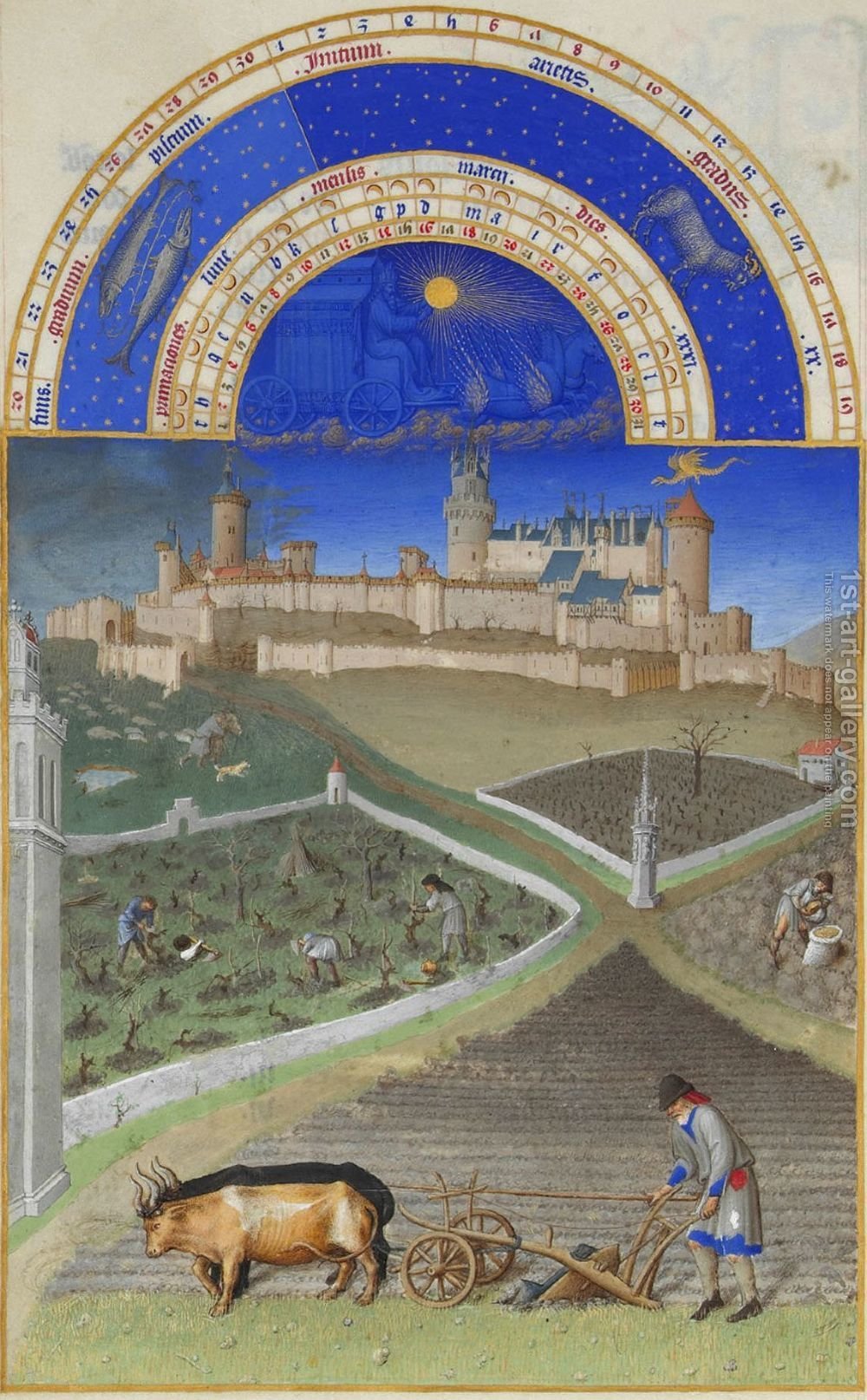
CASTLE UP IN THE HILL
I find quite relevant to today’s situation how the medieval manuscripts portrayed the hierarchical pyramid of the feudal system. Instead of placing information in rational systems which are usually not able to communicate the essence of the topic, they painted the hierarchical system using the real-life perspective as the medium. The added factors of distance and environment do not assume anything as the pyramidal graph does: there is a castle/palace somewhere far from the point of view, mostly up a hill. Behind the first row of high solid walls, we might expect there to be a remarkable amount of security, and what is happening behind those walls is a complete mystery that the first levels of the pyramid can never learn. This obvious lack of transparency leads to corrupt behaviour.

Paradoxically, as the design becomes more legible and explicit, it loses its power due to the fact that this kind of system is based on being ‘out of sight’. Therefore, it also becomes a remarkable, anti-modernist example, one highlighting the importance of overdoing and non-simplifying, just like the political talismans.
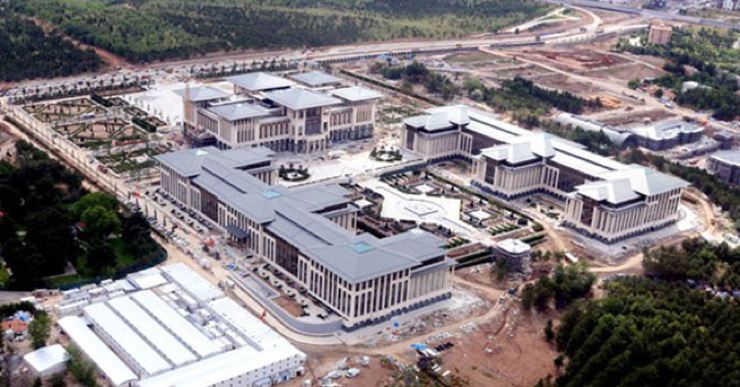
PALACE UP IN THE HILL
Talking about the castle up the hill, the government currently operates across 12 palaces, continuously switching between them. In 2014, they unveiled their newest masterpiece: the Presidential Compound in Ankara. Surprisingly enough this ‘1150’-roomed residency (according to the media) is located on the former Ataturk Forest Farm, part of the same territory that was destroyed in order to build the ‘ZMÖZJZİÖ’. While these two mega-projects re-purpose cultural heritage for arbitrary usage, they also share common aesthetics: the so-called ‘Seljuk architecture’.10 This obsession stems from a desire to re-dominate a land that is associated with secular Turkey with the re-enforcement of nostalgic motifs and style. While the architect of the Presidential Compound, ‘VLSZM ŞZHLO’ argues that this kind of ideology can be associated with oppressive governments, ‘GÜAXZM ÖZİZÖFĞ XZMVZM’ (Ankara chair of the Architects’ Chamber) announced that the palace is the current holder of a world record with its infamous 2250 rooms. 11 As a counter-statement the president repeats his motto: “Itibardan tasarruf olmaz” which translates into: “No austerity in reputation.” Here two main intentions are clearly stated. Firstly, that there will not be any kind of budget-sorting for their projects. Secondly, that most of the things they do is for their own reputation.
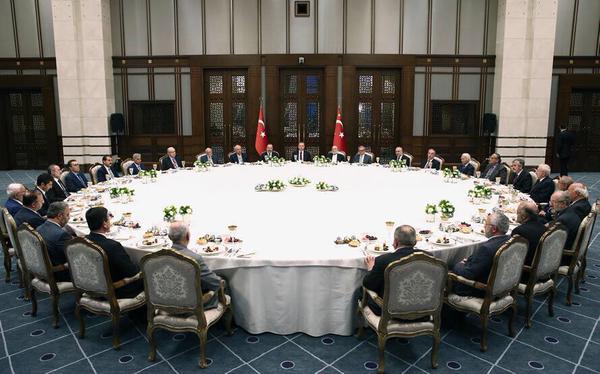
6Chtcheglov, I. (1953). Formulary for a new urbanism. Bureau Of Public Secrets. Retrieved December 14, 2022, from http://www.bopsecrets.org/SI/Chtcheglov.htm 7Milliyet.com.tr. (2019, October 24). İstanbul'da tepki çeken görüntü! Milliyet. Retrieved February 18, 2022, from https://www.milliyet.com.tr/galeri/istanbulda-tepki-ceken-goruntu-6064180 8İlk Atatürk Heykelini çeviren metal Paravanlar Kaldırıldı.(2018, August 19). Retrieved February 18, 2022, from https://www.cumhuriyet.com.tr/haber/ilk-ataturk-heykelini-ceviren-metal-paravanlar-kaldirildi-1060038 9Chtcheglov, I. (1953). Formulary for a new urbanism. Bureau Of Public Secrets. Retrieved December 14, 2022, from http://www.bopsecrets.org/SI/Chtcheglov.htm 10Hasol, D. (2014, September 25). Ankara'da Selçuklu Başkanlık Sarayı(!). Retrieved March 3, 2022, from http://www.doganhasol.net/ankarada-selcuklu-baskanlik-sarayi.html 11Ak Saray, 2250 oda ile dünya şampiyonu. (2015, April 12). Retrieved January 18, 2022, from https://www.cumhuriyet.com.tr/haber/ak-saray-2250-oda-ile-dunya-sampiyonu-252697

➙B☎: Pictured above is the current situation of Ataturk’s sculpture, which is the first monument of both Istanbul and the Islamic world (1926).7
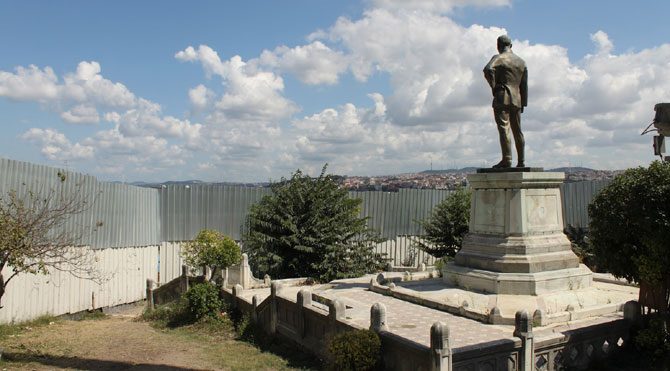
From 2004 to 2018, this sculpture was surrounded and obscured by metal construction curtains.8 While some of these artefacts are being hidden from the sight, new ones are being erected. Depending on the narratives that the government wants to impose, the anti-modernist ideologies are finding their place in altering the city.
Chapter 3: Inventory
“Everyone wavers between the emotionally still-alive past and the already-dead future. We don't intend to prolong the mechanistic civilizations and frigid architecture that ultimately lead to boring leisure. We propose to invent new, changeable decors.”12
These sculptures are far from straight-up branding a city: they carry absurd values, with their appearance depending on the time, place and situation they materialise in. They embrace the ‘still-alive past’ and ‘already-dead future’ that Chtcheglov mentions above. The core of the sculpture is evident for any social change that is occurring. In our case it can be simplified as corruption—because of corruption, their aesthetics and shape change. Moreover, the reason governments commission companies rather than artists derives from the essence of discarding artists’ points of view, political appearance and critical thinking. Companies are perfect sculpture-creating mechanisms for them, as the most important thing is money. As ‘ŞZOQO ÖÜÖOQÖLSOF’13 states in his interview with a local news channel: “I am neither an architect nor a sculptor. My job is commerce.” After a little dialogue he continues with: “We are a commercial company and correspond to any kind of budget. We do not seek to create products with high artistic value.” This way of approaching an issue appears to open up possibilities for various contracts that may be subject to laundering money, where both sides reap profits at the end of the day without any artistic concern. The aesthetics evolve around this. ➙C☎
The sculptures, due to their high number, are better categorised according to their most significant features. These characteristics can vary from their form to their association, size, backstory or technicalities.

The rich and holy content that pomegranate is not able to preserve only by itself is being guarded by few dolphins. Same gesture can be seen in Bursa, where the local football club’s mascots are forming a chamber of prayer.


What if we kissed under romantic storks? Will you be able to acknowledge the heart in negative-space? Therefore the existence of artificial love? Feel blessed?


As the talismans encompass broad diversity, some part of it focuses on traditional heritage and brings the myths and epics back to life, thereby confirming their reality. The epic story of Boğaç Han is a narrative based on a very powerful bull that could vaporize a stone with a single hit of its horns. One day, the sultan took the bull out of the palace, into public space. This created instant fear in the town square, yet unlike the rest of the kids, Boğaç Han was the only one who faced the bull and punched it in the face, hit after hit. This valiant character marked his name on the history with his remarkable moves.

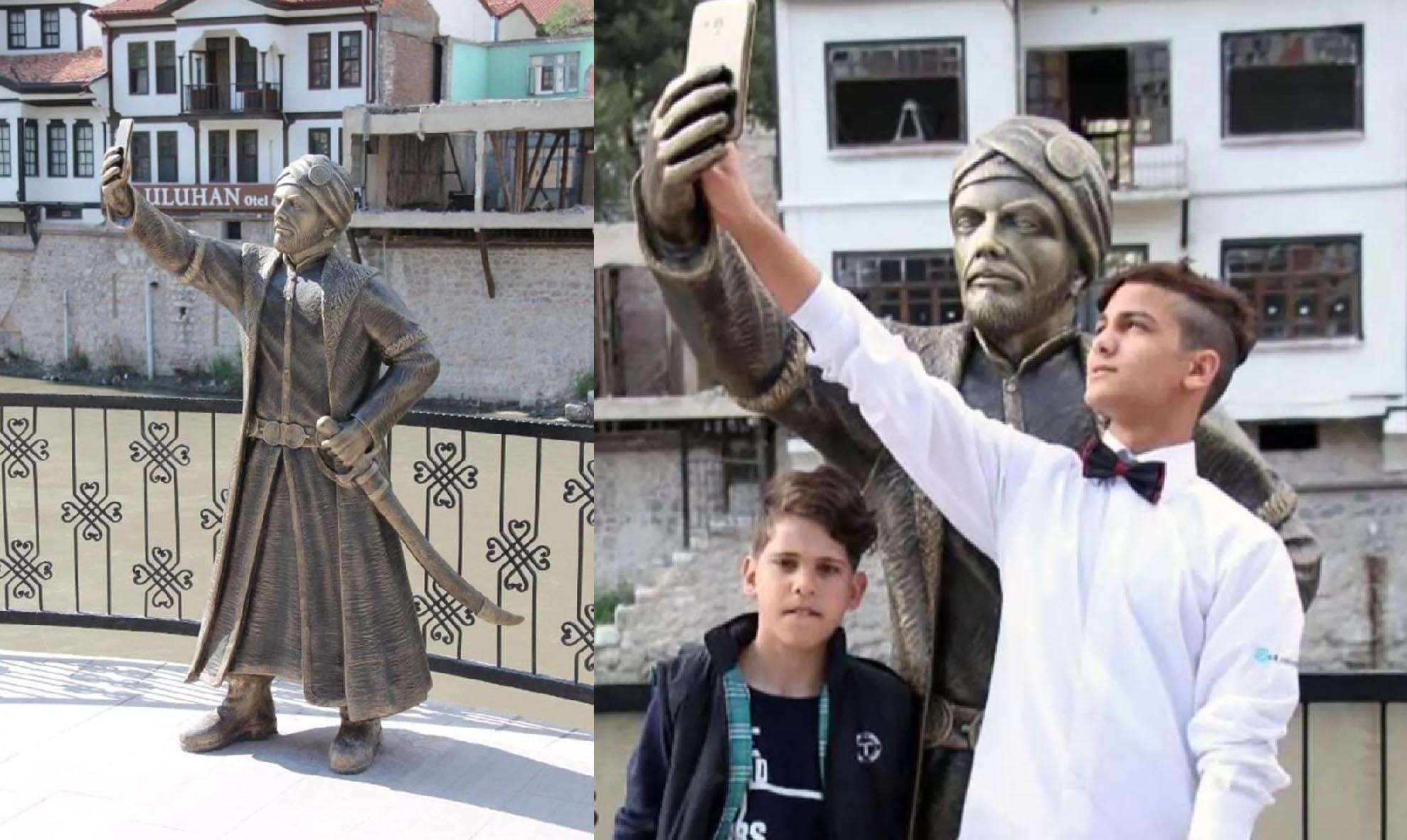
Şehzade is the role given to the sons of the sultan was in the Ottoman Empire. Although it is a highly important position in society—simply because of the fact that a Şehzade is a potential future Sultan—the sculpted version depicts a strange and humorous synthesis. Amasya, known as the “City of Şehzade’s,” displays a modern Şehzade taking a selfie with his right hand (while holding his sword with his left). By doing so, the government takes the historic figure for a “travel in time” for contemporary audiences to relate to, and even interact with it.
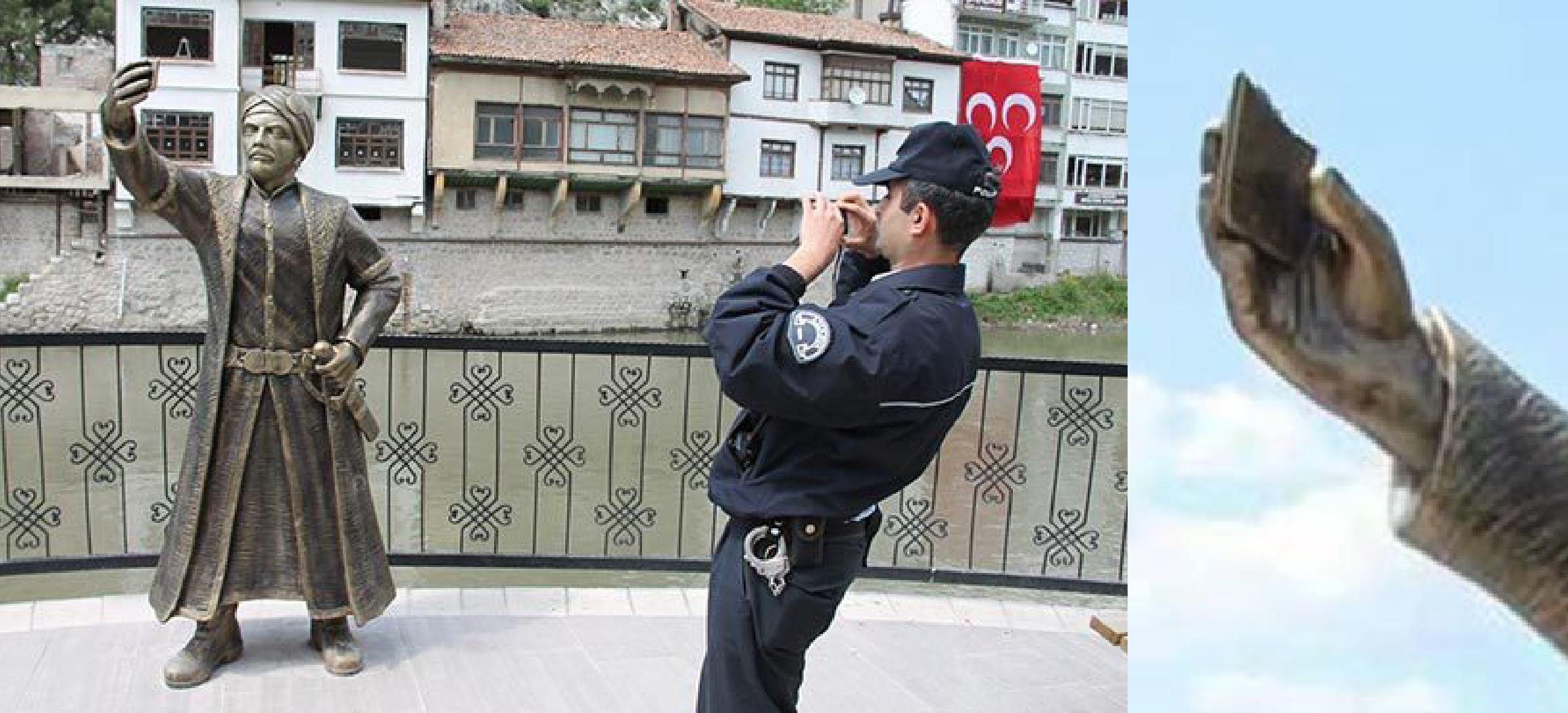
Sadly, over time the Sehzade’s smartphone has become damaged,17 thus becoming another great example of the consequences of altering cultural context.


Another common core of variations is the “Anatolian figure.” This personality appears in traditional clothing while sometimes playing “bağlama”18 next to a highway, and performing a traditional dance together with their enormous friends in other cases.
Some of these sculptures also function as time capsules, considering the relation between the imagery and its geopolitical location. In Gaziantep, a group of camels are placed along a part of the historical Silk Road, visualising how this route appeared centuries ago. The road carries an important role of connecting the East to our lands, therefore it needs to be highlighted.


As the vulgar society and media continues to constantly trivialise this topic, it can never be analysed or trigger the need to delve deeper into its roots. As well, the moment analysis starts, it can be enlightening to find the trivialisation is actually inverted, and we, the society, are being judged by the existence of these sculptures. Looking at this image, we can clearly see that there is an intention to scale up our surroundings even further, to slowly transform our miniature lives into even minor, almost microscopic ones. This way of approaching urban planning appears to be a pattern in Middle Eastern countries: the race to the top. In this case, planting real flowers would not catch any attention and therefore would not spawn the idea that the "government is working." So, the decision is made to scale it up and create their own mini-habitat, revealing the impact of governmental-power and its disdaining function.

“The sublime is something that threatens to overwhelm you and causes fear, but for the spectator the threat is at a level that can be tolerated. It is about the capacity to experience being fearful, but not absolutely overwhelmed, of still being able to tolerate and contain fear.”19
This new visual culture embraces plastic modernity while creating a corruption sublime. Just like peering from the top of a mountain out towards the infinite and glorious nature, standing in front of these sculptures also sparks fear in society—the fear of acknowledging how small a part of this puzzle an individual is, and how weak they stand. This acknowledgment only becomes more intense when the ruler is not nature, but the palace of bureaucracy.
In corruption sublime, the positioning matters. While in nature, elements appear organically and without a conscious positioning arranged by someone, in the city the elements are positioned rather cleverly by the people that profit from it. I find it quite interesting how Hito Steyerl perceives the construction of a linear perspective as a way of portraying a central viewpoint, the position of mastery and control.20 Just like in Foucalt and Bentham’s panopticon, the empowerment of the subject by placing it in the middle appears to have unconscious effects on the society that surrounds it. These “political talismans” can be analysed as a way of state-observation that only communicates to the inner conscious because the outer appearance is mostly considered funny and lacking depth.

A few examples of bread-like sculptures appear to have visual associations with the Eye of Sauron from the Lord of the Rings, which represent the omnipotent features of a god that is all-powerful.
“Visual culture does not depend on pictures but on this modern tendency to picture or visualize existence.”21
The most dominant and popular aspect of political talismans are the re-occuring agricultural elements, each particularly connected to the city they inhabit. Whilst their visuals are the least exciting overall, they possess a great deal of potential information that we can interpret.



Symbolising a whole city with a vegetable strain obviously draws from outdated, unifying intentions. A city is much more than what a person can expect; it comes with million individual stories and carries widescale cultural value. An individual vegetable obviously cannot carry this heavy load, so as a result it simply functions unaware, superficially. Simplifying a city to a piece of polyester… Such a work can only be done by someone that investigates and observes that city in order to come up with accurate compositions and decisions. ➙D☎
These sculptures almost completely abandoned their possible associations with art, coming to a point where they no longer possess individuality, and once there is a new sculpture, the society immediately pushes it into the same categorisation with the others. This avenue of approach reminds me of Jinn’s: as if there is one body of work and it can just transform into whatever it wants. The core will always be the same. Moreover, the influence of the internet community plays a large role in this situation, the same as the agent Mr. Smith in the Matrix: just like a virus that it is not possible to stop because it transforms from one form into another. Despite the fact that there is has been widespread indignation towards them, none have been vandalised or attacked by society, in contrast to colonial sculptures in recent years. This is simply because their appearance does not highlight inequality or oppression.
12Chtcheglov, I. (1953). Formulary for a new urbanism. Bureau Of Public Secrets. Retrieved December 14, 2022, from http://www.bopsecrets.org/SI/Chtcheglov.htm 13Owner of few big companies in the sculpture sector 14Kesler, M. (2021, June 19). Sanat Değil Heykel Komedisi! Yapanlar Bile Sonuçtan Mutsuz... Hürriyet Newspaper. Retrieved December 16, 2021, from https://www.hurriyet.com.tr/gundem/sanat-degil-heykel-komedisi-yapanlar-bile-sonuctan-mutsuz-41835209, translated by myself 15Kesler, M. (2021, June 19). Sanat Değil Heykel Komedisi! Yapanlar Bile Sonuçtan Mutsuz... Hürriyet Newspaper. Retrieved December 16, 2021, from https://www.hurriyet.com.tr/gundem/sanat-degil-heykel-komedisi-yapanlar-bile-sonuctan-mutsuz-41835209, translated by myself 16 https://behavioralscientist.org/how-would-people-behave-in-milgrams-experiment-today/ 17Selfie çeken şehzade Heykelinin Telefonunu Kırdılar. Cumhuriyet Newspaper. (2016, November 21). Retrieved January 19, 2022, from https://www.cumhuriyet.com.tr/haber/selfie-ceken-sehzade-heykelinin-telefonunu-kirdilar-633868 18An instrument from Turkish folk music, a family member of the plucked string instruments. 19Bate, D. (2009). Photography: The key concepts. Berg Publishers. 20Steyerl, H. (2011, April). In free fall: A thought experiment on Vertical Perspective . E-flux Journal #24 . Retrieved January 19, 2022, from https://www.e-flux.com/journal/24/67860/in-free-fall-a-thought-experiment-on-vertical-perspective/ 21Mirzoeff, N. (1998). What Is Visual Culture? In N. Mirzoeff (Ed.), The Visual Culture Reader. essay, Routledge.


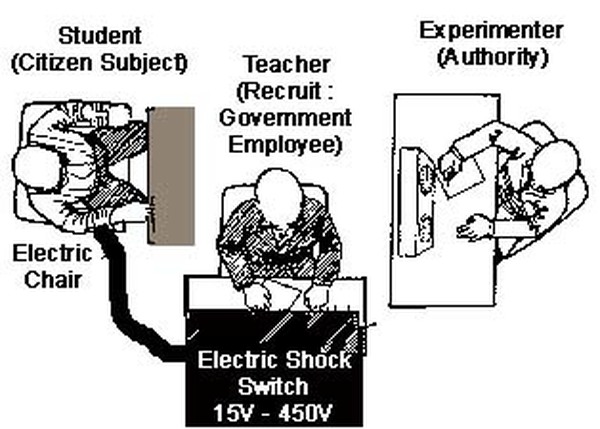
➙C☎: Talking about situationism, the sculpture we see here contributes to the situationist theory from a completely new direction, as we can call it a more recent and brutal variant of the ‘destructive obedience’ that was the Milgram experiment (1961). This famous ‘behavioural study of obedience’ translated into a more modern situation that took place in 2016. The composition presented in these sculptures are based on the '15th of July-controlled-coup attempt,’, portraying the so-called ‘national saga’ where President ‘ÜIVLSZM’ called on the society to go out and fight the military forces as civilians, which therefore deals with how people follow orders, and how people are likely to do unmoral things when ordered to by people of authority. The participants were unaware that the learner was a confederate in both of these experiments.
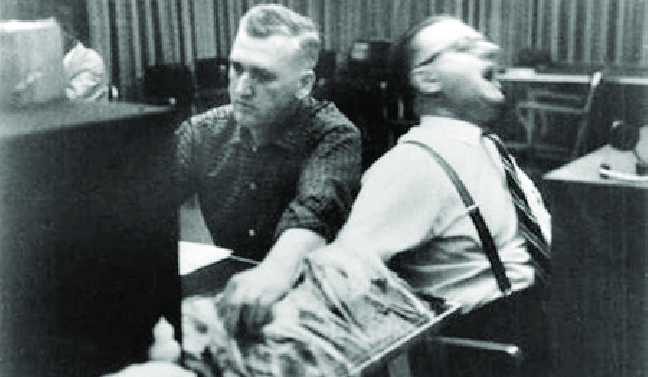
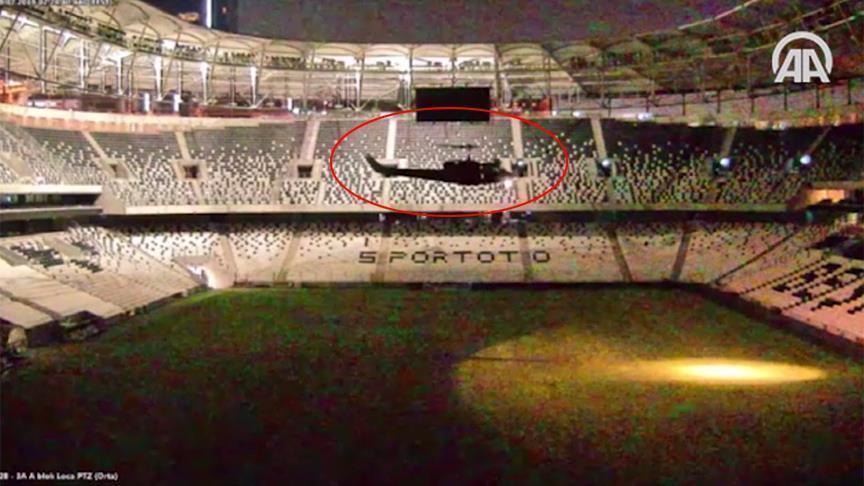
Top image : Milgram experiment
Bottom image: Coup attempt, military helicopter performing unauthorised landing on the Besiktas football stadium; in order to take-over the main news channel building nearby.
While in the first event, the changing variant was the amount of voltage which ranges from 15 to 450V that was being exposed to learners’ skin in the second event the changing variant only gets more brutal. It ranges from the ammo of a pistol to the long-range bullets of attack helicopters and tanks.
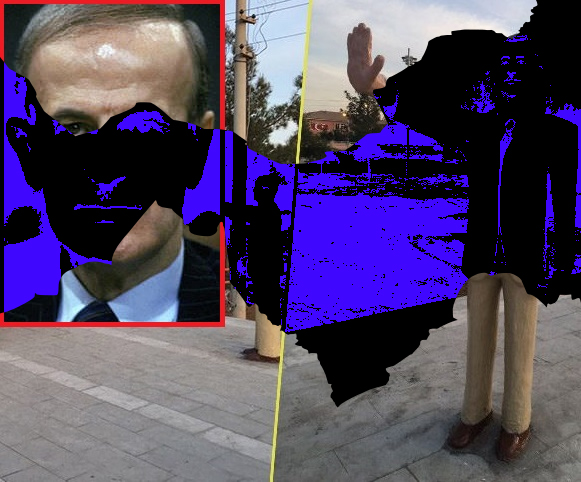
The ‘ÜIVLSZM’ figure was re-sculpted because of the reactions it received due to its appearance being similar to that of the Syrian leader ’YZHŞZİ ZHHZZV’. Later on, this figure was removed completely and replaced with an engraved marble memorial sign.
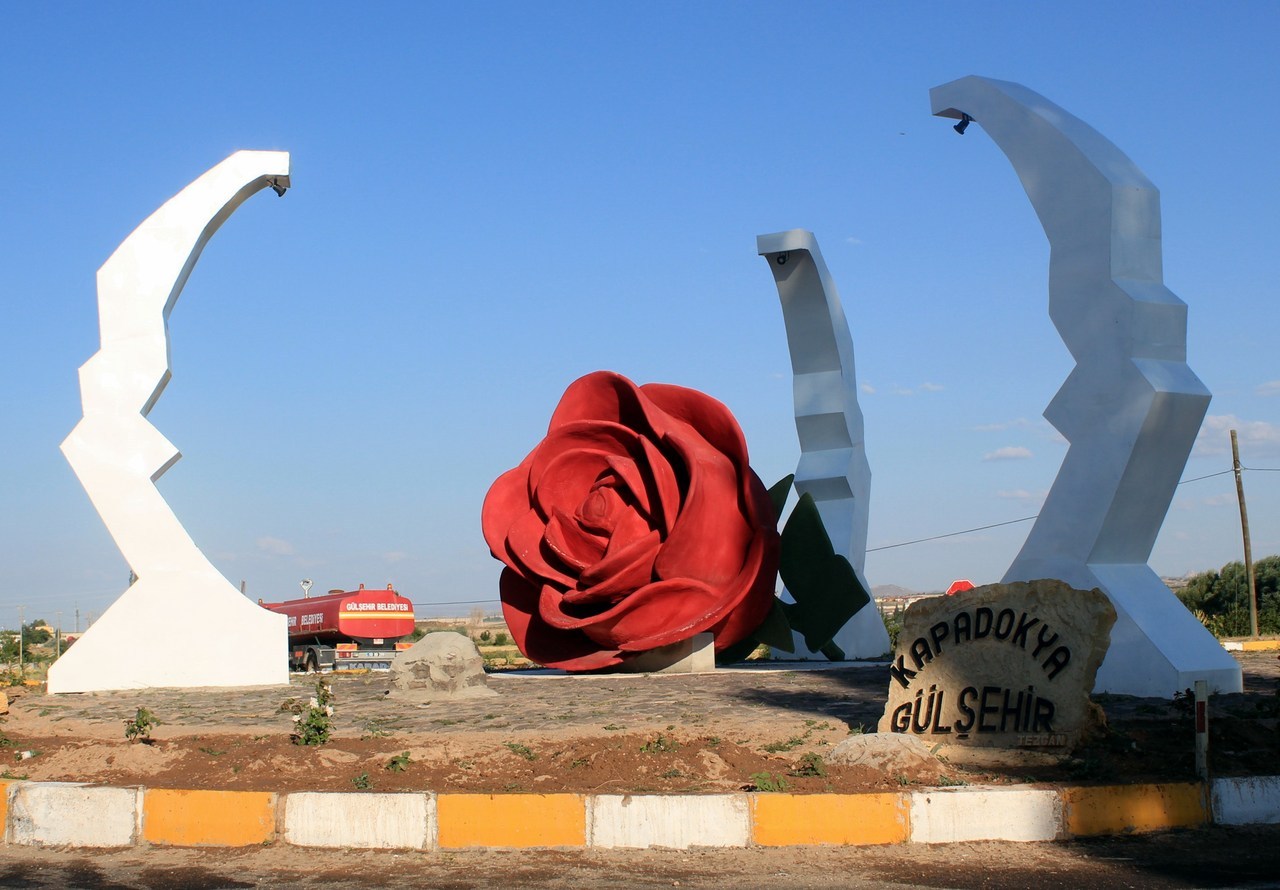

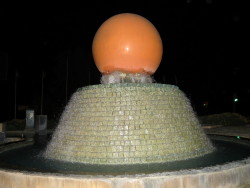
➙D☎: The products that are displayed as the symbol of cities are primarily not even organically grown there, but rather imported from other countries. This tendency towards an import culture clearly reflects the economic reality of Turkey in recent years. These organic products are in some cases presented in sci-fi, portal-like environments which can be analysed as a means of demonstrating that these products are not grown there, but rather “teleported.”
Chapter 4: Bootlegs, Knockoffs and Counterfeits

All these sculptures have significant bootleg aesthetics to them, which is what makes them special—simply because of the fact that they are some kind of a knockoff. In terms of aesthetics, unless it’s a highly intellectual power chamber that acknowledges the existence of the bad, ugly and off-trend, they are far from what a government would purchase. During my interview with one of the largest and oldest companies of this industry, I inquired about their creative process. The answer was simple: “in most of the cases client just sends a photo of an existing sculpture that they like, and we create it.”22 So, in a way bootlegging lies in the nature of political talismans. I therefore evaluate it as the aesthetics of corruption; and in a way corruption is a bootleg of the established system, a way of mocking it and meandering around it. ➙E☎
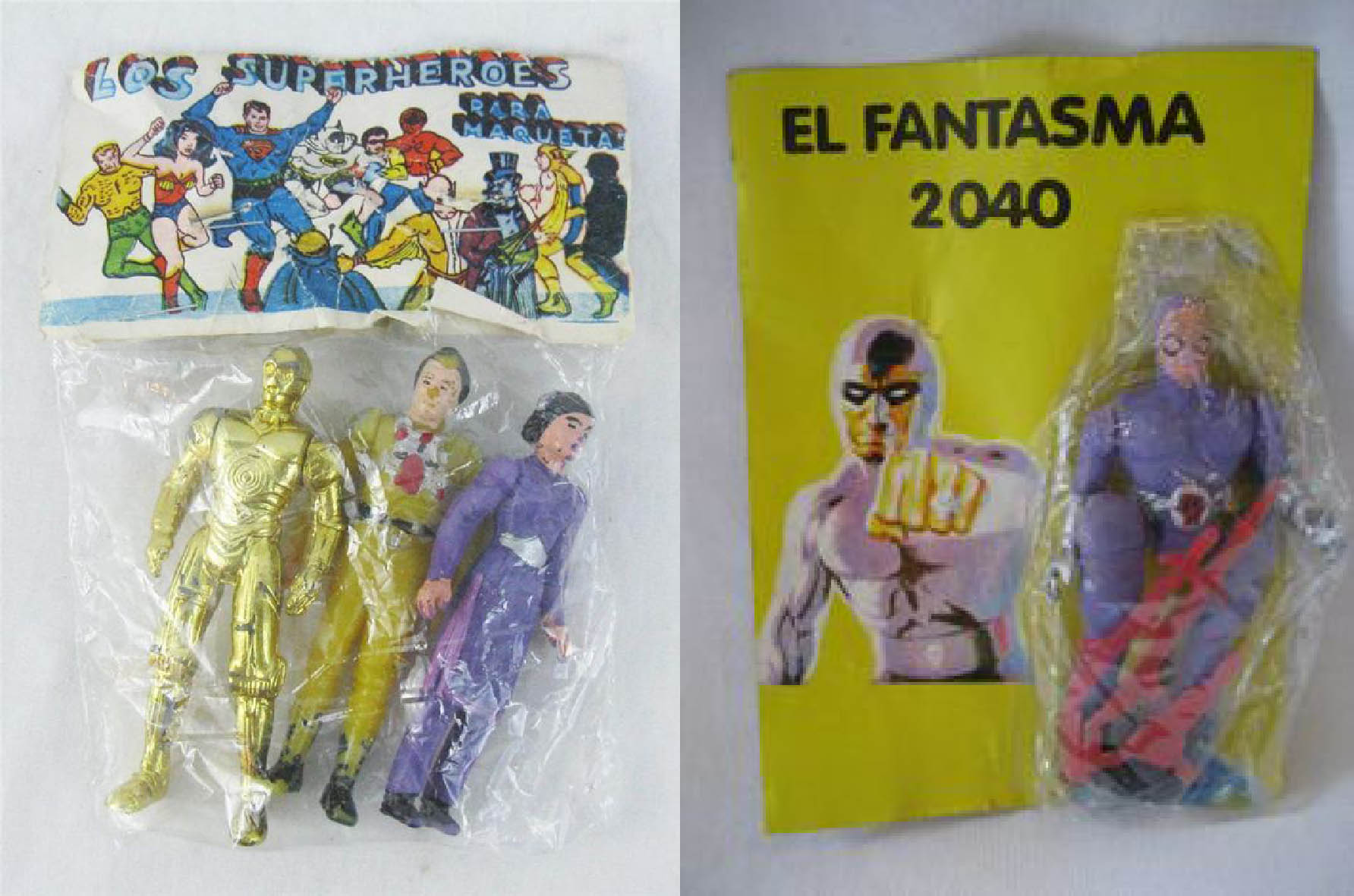
When the designer/collectible toys started to dominate the market, a new anti-capitalist approach was invented. Just like the political talismans, the bootleg toys were also subject to numerous lawsuits throughout history. It is quite paradoxical that a capitalist government is unconsciously contributing to an anti-capitalist approach, or at least it seems like it. With their proportions that are far from reality, out-of-context juxtapositions and badly painted parts, they are just like the Mexican bootleg toys that have been scaled up 100 times. They definitely lack the elegancy and precision that you would expect from a sculpture that is out there in the public. That is how I know that I trust the state’s taste.

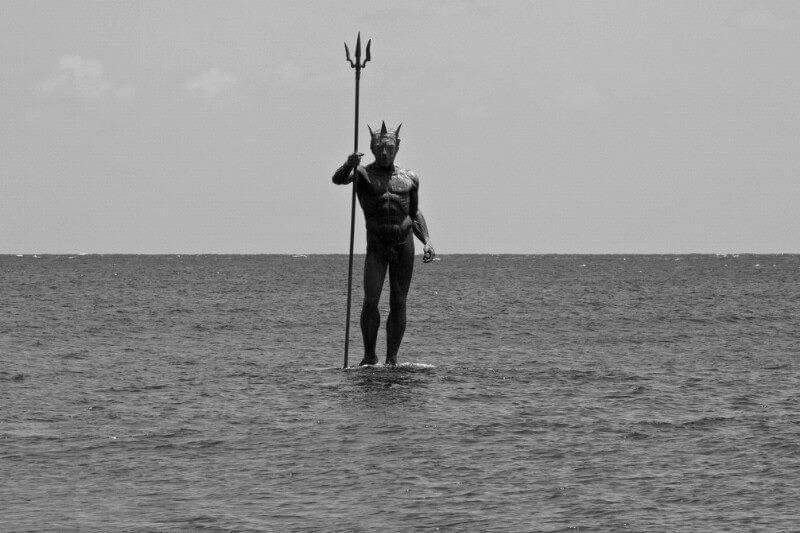
Top image: Posedion sculpture in Sinop, Turkey
Bottom image: Posedion sculpture in Las Palmas, Gran Canaria
Meanwhile, there are common examples around the world of public sculptures completed by artists, mostly as a tribute to an important local artist. In the Turkish case however they are ordered from a company contradicting the notion of bootleg toys. The unconsciousness in this paradox-creation becomes the cherry on top of the cake that the absurd is hiding behind to eat.

Nowadays, bootlegs are also collectible and valuable items: for me and a lot of people, they are even more valuable than the originals. They are anonymous, decentralised, honest, DIY, counter-culture; they have personality, representing protest yet being neutral. They are not only about copying and reproducing, but embracing a style and reflecting it in their appearance, thus making them unique. That is what distances them from the nicely packed, mass-produced toys that one can see in Intertoys, Toys”R”us, and all other kinds of large toy companies. You may agree that one of the most significant characteristics of these toys lies in their collectibility, while the sculptures are not possible to collect due to their enormous size. Although the next argument could be that they are not reproduced, that only applies to some of them. During my phone call with one of the companies, they provided me with the information that a mould is being prepared for each model, and thus the reproductive rollercoaster is open up to any kinds of demands later on. ➙F☎, ➙G☎


An example of the bootlegging fetish is ‘NQHÖÜG ÖÜVQ’, the character that ‘NÜOQŞ’ established as the mascot of Ankara. It is a cat figure which is dressed in traditional Anatolian dance clothing, and is a figure originally from a caricature series started in 2010 by Murat Sayin and published in the Cumhuriyet newspaper’s Ankara edition. In 2012, this figure was mass produced as toys that dance once you press the button on its back. After explaining that 200.000 of them will be produced, he mentioned: “We are now producing 200.000 of this, and we will all see that it won’t be enough and I don’t know what to do when it’s not enough anymore.”24 The same year as production started, Mickey from Disneyland came for a visit to the governmental palace and met the infamous 'NQHÖÜG Cat’. While concluding the meeting, he mentioned his upcoming mega theme park project: ‘ZMÖZJZİÖ’, mentioning that ‘NQHÖÜG Cat’ will hopefully take its place in the park, with his whole family wife, mom, father and kids. ➙H☎
22 Phone conversation with a production company 23 Allahyari, M. (n.d.). MATERIAL SPECULATION: ISIS (2015-2016). Morehshin.com. Retrieved December 5, 2022, from http://www.morehshin.com/material-speculation-isis/ 24 Ankara Kedisi Misket öğrenecek. BeyazGazete. (n.d.). Retrieved February 5, 2022, from https://beyazgazete.com/video/anahaber/beyaz-tv-81/2012/4/9/ankara-kedisi-misket-ogrenecek-265272.html
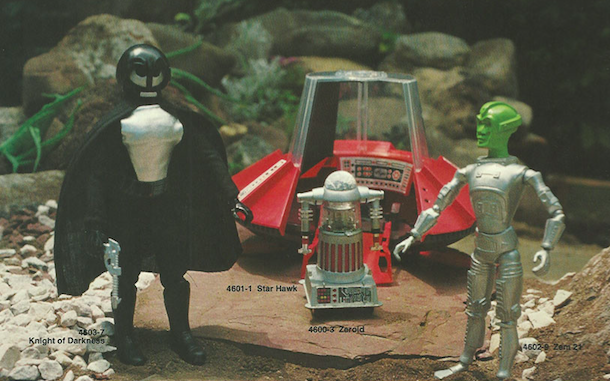

➙E☎: Bootlegs are consequences of the needs, desires and possibilities of their era. In 1977 when the first Star Wars film was released, the youth of that time desired sci-fi, robotic space action figures. In 1978, S*T*A*R TEAM was one of the first series that sought to address these children’s needs and released a line that consisted of three figures and a spaceship. Such an opportunity for exposure led to an endless loop of space figure knock-offs. In the 1980s, Mexican bootleggers launched “La Guerra De Las Galaxias.” The all-time masters of the bootleg production made these figures quite similar to the original ones; instead of knocking off the concept.


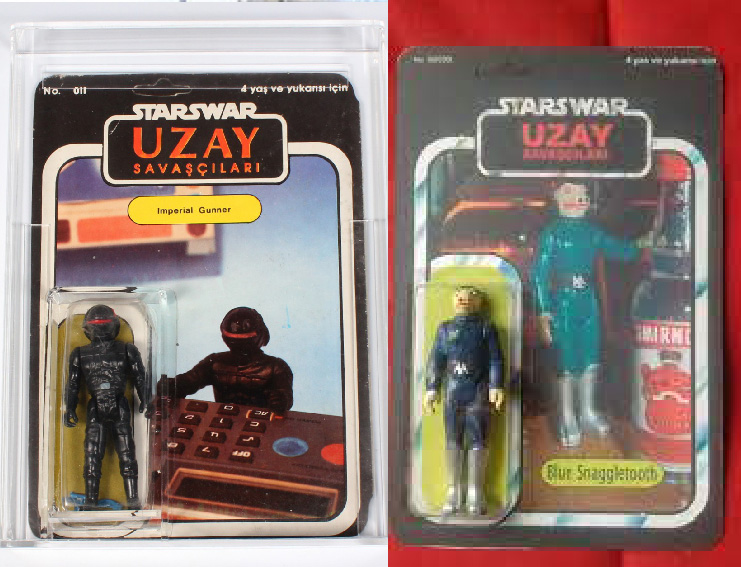
In the late 1980s, Turkish bootlegs were struck with the name ‘Uzay Savaşçıları’. These toys were produced as closely as possible to the original while reflecting their casual attitude in their card-art. This unique packaging displays in what conditions it was produced. The depiction of the Imperial Gunner was shot while sitting behind a calculator; while the Blue Snaggletooth is posing next to a Smirnoff bottle.

➙F☎: Coming back to the act of collecting; yes it is not collectible but what is the real meaning of collecting in the age of digital reproduction? Is it having something in your hand or does having a photo of it also count? If that’s not enough, you can just take your latest iPhone out, and 3D scan it with its distance-sensitive lasers mounted next to your phone’s camera. Moreover, throughout 2015-2016, Moreshin Allahyari worked on a project titled Material Speculation: ISIS, “which is focused on the reconstruction of 12 selected statues from the Roman period city of Hatra and Assyrian artifacts from Nineveh that were destroyed by ISIS in 2015 in a series of highly-publicized YouTube videos.”23

It consists of a series of resin 3D prints of these sculptures, including a flash drive and a memory card. By doing so, this project demonstrates new possibilities in terms of collecting and archiving. In the age of digital reproduction the word collecting means sharing. In February 2016, Allahyari made one of these reconstructed meshes open to public as an “.obj” file and therefore accessible for reproduction. This collection is looking for platforms to become a fully open-sourced project, a gesture which explains that the public elements are part of a shared-cultural heritage. With this point of view, looking back to our infamous political talismans, we see they can definitely be approached as bootleg toys. Not only is the act of collecting possible but even reproducing it is as easy as a few taps on our mobiles…


➙G☎: Ignoring and altering cultural and historical context is a common point in-between bootlegs and ‘political talismans,’ resulting in absurdity and obscurity. ’Obvious Plant’ is the ongoing-project of Jeff Wysaski where he is repurposing found toys in a humorous bootleg form with the help of graphic design. The package’s graphics are custom-made for each toy with their meaning and significance intentionally altered; a core factor that unintentionally comes as a result of this reproductive rollercoaster.
➙H☎: Here are a few screenshots from 2011 when ‘NÜOQŞ’appeared on screen for the first time with his mascots. Altogether, they have performed the traditional dance of Ankara on a live-stream on the TGRT News channel.
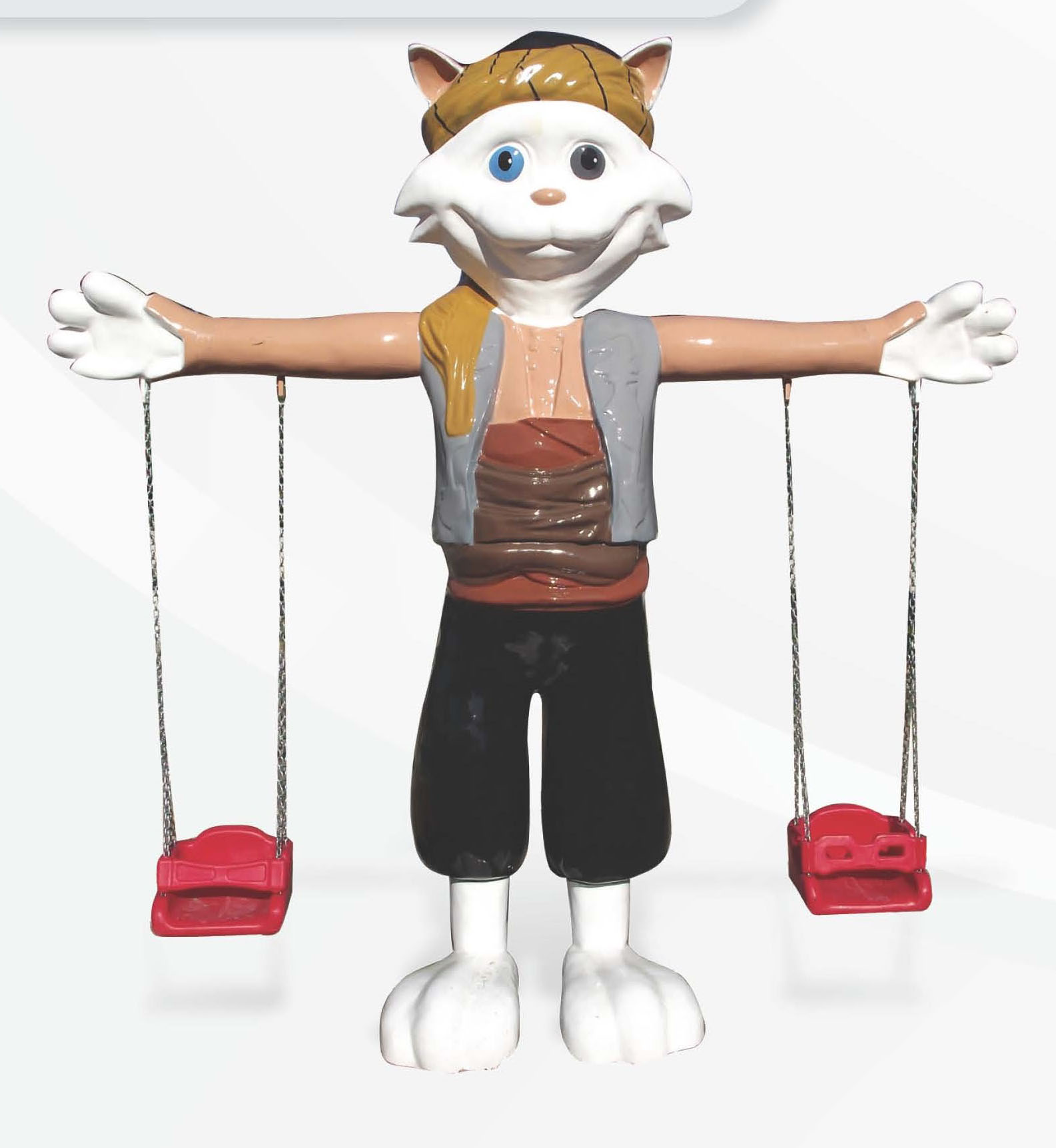
➙H.1☎: As the figure reaches larger audiences, the meta-bootlegging starts. Here is an image from the website of a production company where they created a swing out of ‘NQHÖÜG Cat’.
If you like reasonable I'll be insane
If you like peace and flowers
I'm going to carry knives and chains
I'm going to be your Number one enemy.
(Number One Enemy, Slits, 1979)
Counter-culture seems to be quickly spreading as opposing norms is an artistic trend of the 21st century. When a denial is not possible to a subject-in-growth, it is simply a result of power-structures: the only way to deal with it is to become a part of it. This happens to be the case for the public sculptures in Turkey, too. If the leading party is showing-off with their sculptures, then the only way the other parties can deal with it and conquer the lands that they own is to place their own sculptures. Therefore, this so-called “counter-culture” starts to abandon its key features and becomes the trend itself. Here, is an arbitrary drawing from when I was trying to explain the loop-relation between counter-culture and trend.

In my opinion, the exponential spread and growth of these “theme park aesthetics” across the country is most responsive to the genre of absurdist fiction, where the main character is involved in absurd situations that result in them falling into the “hole” of obscure disillusionment. In the context of this thesis, our main characters are the politicians, with their meaningless actions being the result of their never-ending quest for fundamental purpose in their lives. The sculptures become evidence of their struggle in finding a meaning in their ivory palaces.
The sculptures non-directly communicate concepts like satire, dark humour, disdain, derision and incompatibility. While the philosophy behind it espouses absurdity, I interpreted its aesthetic values as a contributor to Camp. Although these talismans are not camp on purpose, they correspond to what Sontag defines as “camp”: “Indeed the essence of Camp is its love of the unnatural: of artifice and exaggeration. And Camp is esoteric — something of a private code, a badge of identity even, among small urban cliques.”25 Political talismans are ostentatious, unstable, elitist, exaggerated, affected, and theatrical, just as what camp is. According to Rhodes, “it really means something that’s over the top in its concept, that wouldn’t go unnoticed and [that has] a sense of humour about it but it’s not mainstream, and it’s joyous and out of the ordinary …”26
Being a politician obviously comes with a lot of responsibility and formality, and a way of keeping the throne while trying to make things fun comes across with a series of techniques which matches how Cleto defines camp: “…improvising reality as a stage for outrageously ironic self-display and reinvention.”27 This reinvention of the self sometimes occurs by reminiscing of childhood years and thinking about the utopian dream of establishing a themed space: turning a land into an absurdist fiction.
25: Sontag, S. (1964). Notes On "Camp". 26: Bekhrad, J. (2019, May 7). What does it mean to be camp? BBC Culture. Retrieved January 27, 2022, from https://www.bbc.com/culture/article/20190503-what-does-it-mean-to-be-camp 27: Bekhrad, J. (2019, May 7). What does it mean to be camp? BBC Culture. Retrieved January 27, 2022, from https://www.bbc.com/culture/article/20190503-what-does-it-mean-to-be-camp

Chapter 5: Land of Desire

“As our first great project we present the ‘ZMÖZJZİÖ’!” thundered the mayor, wearing a childish expression, at a rally shortly before the election. Behind him, a huge screen turned on and bombarded the crowd with images of rollercoasters, cable cars, and dinosaurs. Surrounded by a facade of Seljuk minarets, domes, and sandstone walls, 'NÜOQŞ TKÖWÜÖ’ announced that this oriental Disneyland could be “incredibly valuable for Ankara’s tourism industry” and “attract 10 million visitors a year.”28
‘NÜOQŞ TKÖWÜÖ’29 is a contemporary artist and cultural enthusiast focused on propaganda while using humour and fun as a medium. ‘ZMÖZJZİÖ’ is just one of his nearly 40 realised and unrealised ideas besides the artificial-Bosphorus, the city gates, the Museum of Faith and History, Plane Hotel and the dystopian Dervish temple. ➙I☎, ➙J☎

‘ZMÖZJZİÖ’ plays an important role in being a large body of work of concluding all kind of governmental obsessions. It becomes a mega-accommodation for those political talismans, leading me to realise that the city is also transformed into a themed space by containing these sculptures.
The park’s name was changed to ‘Wonderland Eurasia’ while it was still under construction, introducing itself as a synthesis of the East and West in its promotion video. This new name carries semiotic values for me as I grew up around the tiny body of water that splits these two continents.
This mega-project is currently world’s largest abandoned theme park. The dreams of the Justice and Development Party’s 5 million visitors annually is now being guarded by approximately 10 security guards with a strict door policy where only the mayor and president can access the space: “Having spent just six months operational – and with a change of mayor in Ankara – the park’s gates are shuttered and the project threatens to become a giant white elephant.”32 ➙K☎





Screenshots from the Youtube video of 'Explomo' where they break-in the park and go through what's left behind.
“The park included 2,117 rides, a parking lot for 6,800 vehicles, and a hotel to host out-of-town visitors, which ‘TKÖWÜÖ’ said in 2018 cost the equivalent of 300 million US dollars. In 2019, ‘ÜIVLSZM’ put the price of the project at 255 million dollars. More recently, ‘BZDZĞ’33 revealed the actual cost of the park to be 801 million dollars.”…“A point of contention between political parties, the park—run by a private company, backed by public funds – now costs the municipality a million Turkish liras daily.”34
‘GÜAXZM ÖZİZÖFĞ XZMVZM’35 followed up: “Ankara’s budget was used inefficiently. The 801 million dollars that was announced is only the tip of the iceberg.”36
Excerpt from the 3D promotional video of the park.
The park offers absurd juxtapositions of different eras that can be observed from a single point of view. Standing next to the railway, one can observe turquoise Seljuk minarets lying behind the mechanical, partially-moving dinosaurs while a childish replica of a steam locomotive is passing by. It ignores the linearity of time and fantasises about all of these eras occurring within times and border of a Sunni Muslim empire. An empire with such an impactful visual culture is being morphed into an extravaganza curation of different aesthetics. ➙L☎

The entrance to the park actually appears to be a mash-up of several Seljuk-era mosques such as “Ağrı İshak Paşa Camisi, Amasya Burmalı Minare Cami, Bitlis İhlasiye Medresesi, Diyarbakır Selahattin Eyyübi Cami, [and] Erzurum Çifte Minareli Medresesi”37 When we get away from the fixed point of view and understanding of a linear horizon, we see variations of motives that evolved from the Seljuk star. Starting from the top point and moving clockwise, these eight corners represent: mercy, kindness, patience, truth, keeping secret, loyalty, generosity and gratefulness to god, respectively. Some of these meanings do not truly overlap with a corrupt government, although it creates a relaxing environment for the audience. ➙M☎
The whole amusement park can be seen as landscape art, given it has a lot to do with the space it has conquered. It is a conscious transformation of the heritage that Ataturk left with the hopes of being a source for future agricultural needs. The current government had to use legal manoeuvres in order to make use of this desired land; Thus, ‘XZMVZM’ criticises the theme park as “an urban crime” and “an ideological betrayal to Atatürk’s will.”


Although it can be assumed that “in Turkey, historically and culturally rich Anatolian lands, provide a great opportunity for especially history and culture-oriented theme parks in the future.”40, building a stone-hedge next to a bunch of Cappadocian fairy chimneys feels straight out of absurdist fiction. It is visible that—in the process of planning the park—there was a great deal of intuitive and associative decisions being taken, which became a great inspiration for the how this thesis has been written.
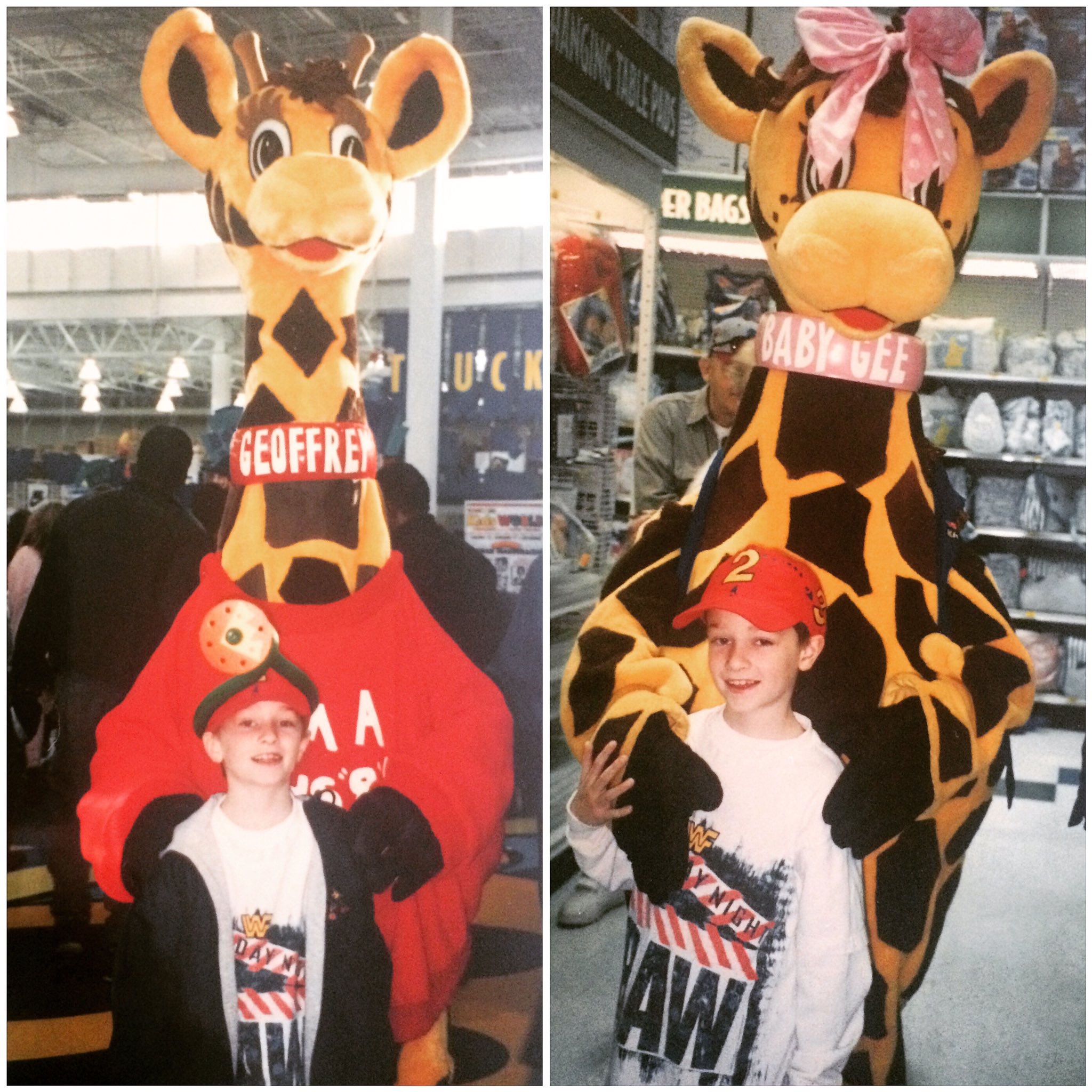
My first experience with themed spaces was the hairdressers in Toys”R”Us and the “fun zones” contained within various shopping malls. Nevertheless, as years passed the fantasy hair salon still vividly lives on in my memory. I remember stubbornly refusing to go somewhere else, somewhere “grown-up.” It had a great charm to it with the Toys“R”Us giraffe cutting my hair exactly the way I wanted, in a theme-park like environment.
I see similarities in how these politicians curate the public space, with their childish passion and way of living, being surrounded with a themed atmosphere. In my case it was a refusal to grow up, so therefore in their case it also must have something to do with the grown-up bureaucratic environment that they inhabit. In the end, their priority also becomes to have some fun instead of dealing with governing such a crowd, as can be seen from their funky mega-projects.
"A mixed term of imagination and engineering, called “Imagineering” that was first defined by Walt Disney himself become the actual name for this interdisciplinary phenomenon of constructing a theme park. Imagineering encompasses imagining worlds and spaces from a pool of possibilities and their realization through multiple types of engineering."41

Left image: Sceenshot from promotional video Right image: Pleasure Garden with a Maze, 1579-1584, Lodewijk Toeput
Looking back on the timeline, way before modern engineering we can see that the concept of theme parks evolved from various heterotopias such as pleasure gardens, circuses and fairs. These collective spatio-temporal entities can be seen as exhibitions or rituals/purification events, and throughout history the term theme park took on its own unique aesthetics and qualities.
The concept reached its current stage in the late 19th century. As the technological possibilities expanded, its aesthetics and aim also evolved alongside it, resulting in a “land of desire” in the meta-modern world. It can be seen as a unique spatio-temporal place; as Botteril wrote in 1997, "...theme park is a cultural product of entertainment that corresponds to the needs of late-modem capitalist society and only makes sense in this context.”42 ➙N☎
The idea of curating such a themed space is appealing, yet can attract much reaction and outcry. Re-interpreting historical elements alongside imaginary concepts can appear offensive and destructive for some, while others opt to detach notions of the real world from the imaginary universe, in order to enjoy it. ➙O☎
Although ‘ZMÖZJZİÖ’ became subject to topics of even greater importance, it did not face such backlash simply because it was not executed by external sources, but rather the government itself.

28Blaser, N. (2014, April 3). Turkey's weirdest mayor won't be distracted by electoral fraud allegations. VICE. Retrieved December 21, 2022, from https://www.vice.com/en/article/vbnp3y/turkeys-weirdest-mayor-wont-be-distracted-by-electoral-fraud-allegations 29Former mayor of Ankara 30A project where the aim was to explain the miracles of the Quran through a spatial experience. 31750 Milyon Dolarlık Ankapark Muamması Sürüyor: Belediyeye Devri Durduruldu. KARAR. (2021, June 26). Retrieved November 28, 2022, from https://www.karar.com/guncel-haberler/750-milyon-dolarlik-ankapark-muammasi-suruyor-1622478 32Ankapark, Turkey’s multi-million dollar junkyard. Inside Turkey. (2021, September 17). Retrieved December 2, 2022, from https://insideturkey.news/2021/09/17/ankapark-turkeys-multi-million-dollar-junkyard/ 33Current mayor of Ankara 34Ankapark, Turkey’s multi-million dollar junkyard. Inside Turkey. (2021, September 17). Retrieved December 2, 2022, from https://insideturkey.news/2021/09/17/ankapark-turkeys-multi-million-dollar-junkyard/ 35Ankara chair of the Architects’ Chamber 36Ankapark, Turkey’s multi-million dollar junkyard. Inside Turkey. (2021, September 17). Retrieved December 2, 2022, from https://insideturkey.news/2021/09/17/ankapark-turkeys-multi-million-dollar-junkyard/ 37Ntv. (2019, March 18). Wonderland Eurasia için Giriş ücretleri belirlendi. ntv.com.tr. Retrieved February 19, 2022, from https://www.ntv.com.tr/ekonomi/wonderland-eurasia-icin-giris-ucretleri-belirlendi,F2o4tDeUw0y-JK2E--J1Fg 38Mynet.com. (2015, April 2). Ankapark'Tan Otorobotlu i̇pucu. Mynet YurtHaber. Retrieved February 2, 2022, from https://www.mynet.com/galeri/ankaparktan-otorobotlu-ipucu-180101754312 39Iha.com.tr. (2015, April 8). İhlas Haber Ajansı. Retrieved January 26, 2022, from https://www.iha.com.tr/haber-gokcekten-otorobot-acikalmasi-453726/, translated by myself 40Eyuboglu, G. (2018). Theme Park as a Socio-Cultural and Architectural Program: A Critical Review of Ankapark, Ankara. 41Eyuboglu, G. (2018). Theme Park as a Socio-Cultural and Architectural Program: A Critical Review of Ankapark, Ankara. 42Botterill, J.(1997) “The "Fairest" Of The Fairs: A History Of Fairs, Amusement Parks, And Theme Parks,” 43Chtcheglov, I. (1953). Formulary for a new urbanism. Bureau Of Public Secrets. Retrieved December 14, 2022, from http://www.bopsecrets.org/SI/Chtcheglov.htm 44Eyuboglu, G. (2018). Theme Park as a Socio-Cultural and Architectural Program: A Critical Review of Ankapark, Ankara. 45Riding, A. (1992, April 13). Only the French elite scorn Mickey's debut. The New York Times. Retrieved March 4, 2022, from https://www.nytimes.com/1992/04/13/world/only-the-french-elite-scorn-mickey-s-debut.html
➙I☎: “Rather than painting, welding, and molding, artistic strike work consists of ripping, chatting and posing.” writes Hito Steyerl, stressing the position of the contemporary artist. In our case, we can envision the politicians as the contemporary artists, and the production companies and workers as the traditional ones.
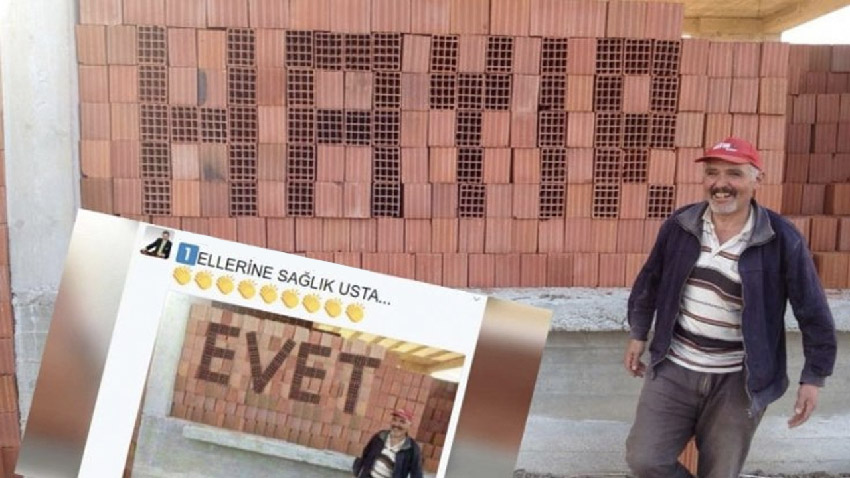
➙J☎: Although this thesis concerns the physicality of these works, I feel the need to also mention the digital ones for a better overview of his artistic practice. Here is a construction worker that built the word ‘no’ using a creative arrangement of bricks. Here, the word ‘no’ represents their reply to the ruling party’s 2017 constitutional referendum proposal. The overlaid photo is a tweet from ‘NÜOQŞ TKÖWÜÖ’, displaying a photoshopped version of the image where the word ‘no’ has been turned into ‘yes’. He is thanking the worker for their effort as a description…
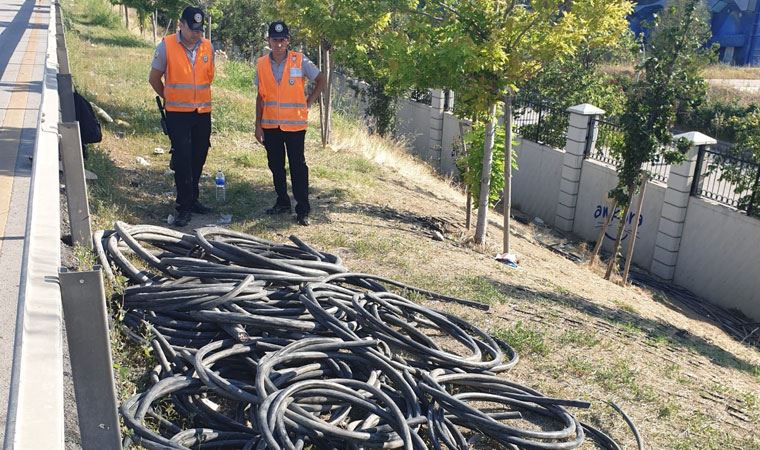
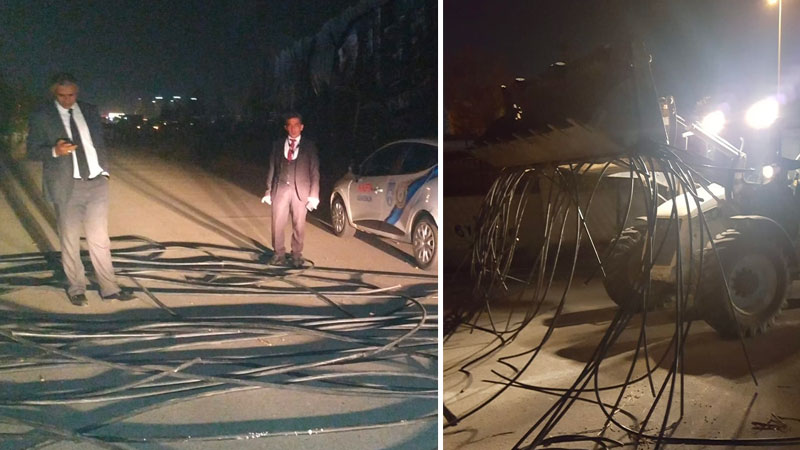

➙K☎: As such a large territory is being protected by just a team of security personnel, there might be some opportunities for thieves that would like to steal some material for reselling purposes. Looking at the news articles, the most popular demand seems to be for cables. Several months after coming across these articles, I discovered a video of two foreign urban explorers that managed to enter the park. During their walk-through, they came across a bolt cutter that was lying next to bunch of cut cables placed in a wheelbarrow. Connecting the dots, I could come to two potential conclusions: either the thieves were not able to escape and had to leave these “artefacts” behind, or these news articles are just further staged propaganda.




➙L☎: Observing the photos from the opening and testing days, all these serious people look like they are having a great time. Their draconian attire harmoniously contrasting the playfulness of the vibrant environment. This vibrance seems to trigger something inside them, something that can give them such a joyful expression which had presumably been eliminated years ago through the thrill of governing.


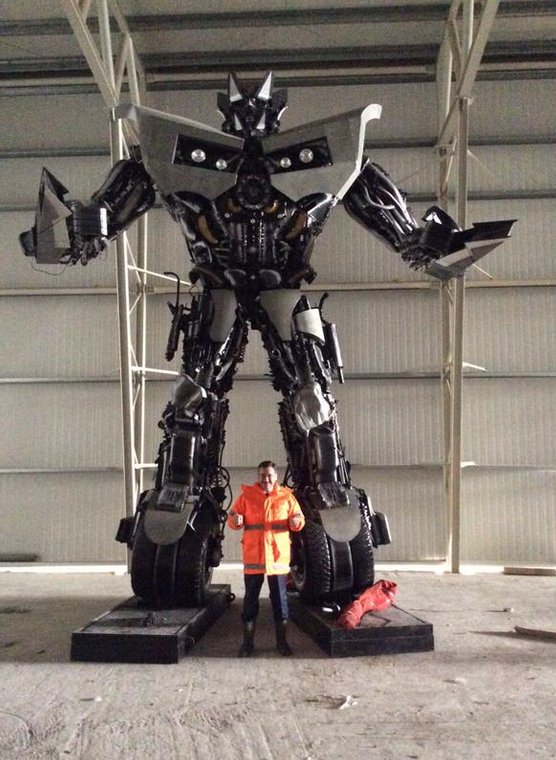

➙M☎: ’Otorobot’ seems to be the most important part of the park; as ‘NÜOQŞ TKÖWÜÖ’ shared some evidence from their relationship with the robots that takes place there, before the opening. Unlike the rest of the park, this part presents itself as a futuristic exhibition—almost a sci-fi museum. Every detail becomes a living testament to the effort that has been put into it in terms of spending the highest amount of money they could … From the moment the huge sculptures of transformers standing in front of waving LED Turkish flags are seen welcoming the audience at the entrance, the environment changes into that of a steam-punk slaughterhouse.


➙M.1☎: According to a blog38 that I have came across on the internet, the aim of ‘Otorobot’ is actually to create a 4D cinematic experience wherein a large group of people attends a narrative based on ‘NÜOQŞ TKÖWÜÖ’s robots saving the world. These moving and talking robots take the viewers on a heroic adventure which can be seen as a parallel narrative to ‘TKÖWÜÖ’s autobiography wherein he is attempting to create a heroic figure out of himself.

➙M.2☎: As the robotic sculptures appeared in the city several times as spoilers before the park has opened, they became the subject of several lawsuits launched by the Chamber of Architecture. ‘NÜOQŞ TKÖWÜÖ’ mentioned that these cases were launched based on ideological reasons, and their word is not an important matter. He followed up with a humorous threat: “Be respectful to our robots. Watch out for them if you come take a visit when ‘ZMÖZJZİÖ’ is open, they might ask for payback.” 39
➙M.3☎: This also becomes another bridging point for how ‘ZMÖZJZİÖ’ and political talismans can be analysed as two parallel case studies and how they feed from each other.

Slinky Dog Dash, Disney Hollywood Studios
➙N☎: “There was a certain charm in horses born from the sea or magical dwarves dressed in gold, but they are in no way adapted to the demands of modern life. For we are in the twentieth century, even if few people are aware of it. Our imaginations, haunted by the old archetypes, have remained far behind the sophistication of the machines. The various attempts to integrate modern science into new myths remain inadequate”43 wrote Chtcheglov in 1953, two years before the first Disneyland ever opened. We could argue that his words/dreams came true with the establishment of theme parks, where these mythical charms are adapted to the machine technology and the demands of capitalist society.
➙O☎: “Yet the theoretical framework and its actualizations were undervalued, prejudiced and neglected from time to time in both architectural and cultural fields in Turkey as in the whole world. For instance, Disneyland Paris was once speculated as a “Cultural Chernobyl.”44



Screenshots from the video 'Eurodisney: historie' (1992)
➙O.1☎: Disneyland, as an established American corporation, experienced chaos and regret with the opening of the so-called EuroDisney. French intellectuals were envisioning their lands being commercialised by this distasteful, “intensely American blend of processed magic.”45 While the park was under construction, it was highly criticised by different groups of society for various reasons. While the intellectuals were worrying about their visual culture, French farmers were protesting against the claimed land by blocking the entrance road with a swarm of tractors. Furthermore, during the opening ceremony, left-wing rioters protested by throwing various materials at the stage.
Chapter 6: Visual Identity of Corruption
“Due to the invisible nature of corrupt transactions, corruption is difficult, if not impossible, to visualise.”46 An image whose function is to communicate corruption appears to depart from the stereotyped path of playing with symbols like: money, shaking hands and the unrecognisable silhouettes of businessmen; although, this imagery is neither enough nor accurate.
A way to research a more accurate representation could be to reverse the method and search for anti-corruption organisations and their visual representations. Olli Hellmann focuses on the invisibility of corruption and how the anti-corruption industry visualises this “rare visual evidence”47 with a focus on photography competitions run by Transparency International.
Furthermore, as the article concludes, TI’s visualisation does not go further than using colonial stereotypes and Northern/Western-centric historical narratives, which is neither fun nor playful especially in the 21st century. Looking at the logos of the anti-corruption organisations, it also appears to lack the playfulness I am looking for. It uses cliché-ridden symbols related to law and equality, while corruption can take on many forms even legally. Hellman also points out how large of a role this visuals play in terms of constructing knowledge and structuring what constitutes legitimate actions, in the manner of fighting corrupt behaviour.
“One of the most striking features of the new visual culture is the visualization of things that are not in themselves visual.”48 mentions Mirzoeff under the title ‘What is Visual Culture?’
Luckily enough, the Turkish government has offered alternative narratives in this debate surrounding visualisation with their contributions to the new visual culture. Both the sculptures and the theme park play a big role in creating a “visual identity of corruption.” Although these creations may not be the best manner of explaining what corruption is to someone that is distant from the topic, they can become quite meaningful with a bit of context.

Their relation to the corrupting country is not something conscious, it is just the output of an evident-driven analysis. Political talismans, unlike politicians themselves, are neither against nor with corruption—they are just part of a collection of inauthentic evidence that lies between being an artefact and a masterpiece, according to anthropologist James Clifford’s diagram. In a way, it creates its own unique vocabulary of public interaction.
FUNDAMENTALS OF CORRUPTION
“Rogow and Lasswell (1963) have studied the personal lives of politicians and political bosses in the United States, and have developed a model of the psychological profile of the politician that relates unfulfilled childhood needs to corrupt behavior.”49 This crucial discovery is highly relatable considering the behaviour of Turkish politicians. Their interest in childhood figures and aesthetics dovetails perfectly with their illogical acts.
Macrae (1982) offers a definition that is sufficiently broad for our purposes in the present study. He refers to corruption as an “arrangement” that involves “an exchange between two parties (the 'demander' and the 'supplier') which (i) has an influence on the allocation of resources either immediately or in the future and (ii) involves the use or abuse of public or collective responsibility for private ends.”50
The haphazard management of public funds leads to enormous wealth inequalities. M. Shahid Alam states that inequality in the distribution of income can cause this corruption monster to grow, while Michael Johnston states that corruption causes greater inequalities in terms of income distribution. Therefore, a joint causality exists in between these two terms.

2017 Europe income inequality graph, Turkey in second place after Serbia ,Source: Euronews
1. POWERDISTANCE AND NEPOTISM
In a democratic system, responsible people are placed into their positions according to their skills and background, which in the bigger picture “makes the cogwheels turn.” Each gap in a system needs to be perfectly covered by that specific person so that an organisation can perform best. As 20 years have passed with the same ruling party in office, numerous points of concern have slowly started to rise to the surface. Today, the aim is no longer about fitting the gears perfectly and making the system run flawlessly, but rather to collect familiar cogwheels and transform it into a family environment. It does not matter if the machine will ever work again, the parts are placed and set, and will therefore receive their share. This paternalistic share, of course, comes in return for a subordinate’s dependence and loyalty. In high power-distance countries, ever-expanding families dominate every potential branch and thereby become millionaires.
“Decisions are not made on the basis of merit, but on the basis of a balance of favors and loyalty. A paternalistic system thus leaves considerable room for corruption in the form of favoritism and nepotism.”51
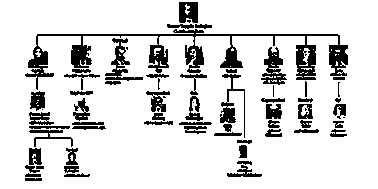
The family tree of nepotism in current governmental system, Source: T24 News
In the article “Wealth, Culture and Corruption,” Bryan W. Husted refers to Takyi-Asiedu’s take on power-distance: "Scandals involving people in authority are, almost always, covered up as long as they remain in power”. Husted concludes these cover-ups as a logical consequence of adherence from underlings. Applying this knowledge to the current state of Turkey, we see the consequences of conflicts that occur due to a nepotistic way of governing.

After the revelation of the president's health problems, the fight for the “golden throne” became even more intense with the would-be battlefield widening in scope. With the corrupt system becoming a huge internal mess, 'YÜİZG ZOYZBİZÖ’52 and ‘HEOÜBNZM HLBOF’53, a duo that was part of the deep state, now were caught on camera giving each other an evil smile after hitting one another with their shoulders. This act represents a little hint to society as to how this ‘cover-up’ has started to fray when there are internal problems in the core governing group. In light of disregarding the promised loyalties, a corrupt system only becomes more corrupt as the backstage starts light up.
“After serving in ministerial posts for nearly five years, I took the decision not to continue my duty [as finance minister] due to health issues,” says ‘ZOYZBİZÖ’, the son-in-law of president ‘ÜIVLSZM'.54 Surprisingly, their resignation came on the 8th of November 2020, which is the day after ‘ÜIVLSZM' sacked the central bank governor due to a 30 percent drop in value of the Turkish Lira against the US Dollar. ➙P☎
2. UNCERTAINTY AVOIDANCE AND FEAR OF ABSTRACT
Movement creates a lack of clarity—that is the nature of motion blur. Paradoxically, the movement that I am interested in does not welcome any unclarity; it even appears to be the core of this movement, and defining the style of political talismans. The figures that are portrayed with these sculptures are mostly depicting a character from the past and not allowing any uncertainty through. This reduces the risk of public reactions through the help of familiar appearances. ➙Q☎
Hofstede (1997) defines this avoidance of uncertainty as “the extent to which members of a culture feels threatened by uncertainty or unknown situations.”58 He also mentions that corruption is a mechanism that can be used to reduce uncertainty. However, the people in power are threatened by this uncertainty which visually translates into abstract shapes and brutalism.
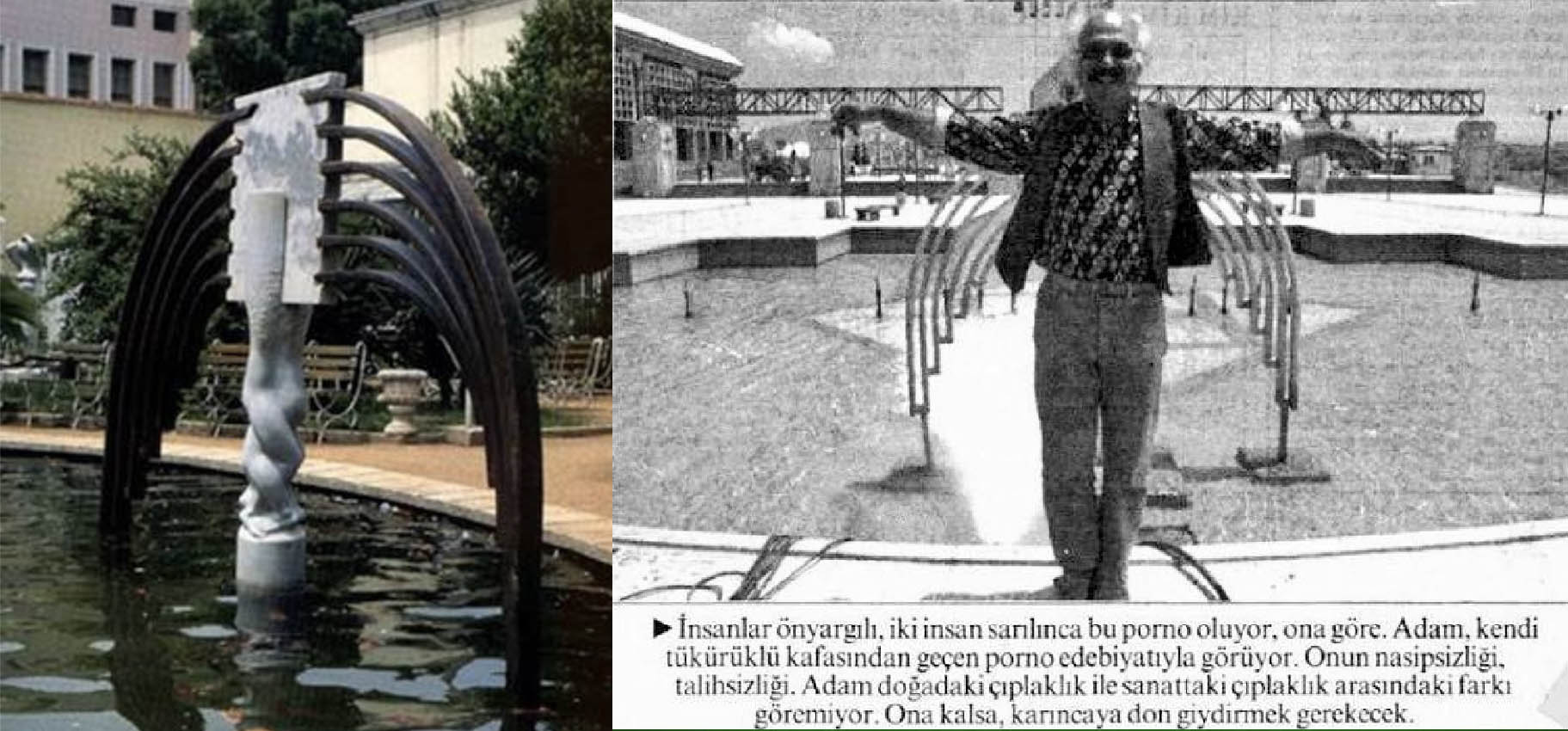
In 1994, ‘NÜOQŞ TKÖWÜÖ’ viewed the artwork “Periler Ülkesinde”59 for the first time, in his own territory, Ankara. He immediately asked for its removal after spitting on it. Besides his contemporary artistic career, we can see that he actually started as an art-critic. In this ideology of criticism, undefinable structures are strictly immaterial.

Unfortunately this was not the only time Aksoy’s public artworks had suffered from the avoidance of uncertainty. In 2006, the sculptor Mehmet Aksoy unveiled the “Humanity Monument” in Kars.60 Five years later, when President ‘ÜIVLSZM’ visited the city, his eyes were confronted with this enormous brutalist structure which led to confusing moments as he grappled with what he saw. He entitled these concrete blocks as “ucube” which translates into something like “monstrous, weird and freak.” After this designation, he asked for the disintegration of the sculpture.
Based on what is preferred to be seen and what is being hidden, we can conclude that there is definitely something to do with the ‘recognisability’ of a sculpture. It is the fear of abstract. If something does not have clear associations, it is considered dangerous; the same goes for the rise of graffiti in Turkey, with the first sprayers being denounced as Satanists. Although it was far from it, unrecognisable letters and forms were immediately alienated by society. This stems from the range of possible meanings they could carry. ➙R☎

In World War II, the moment Allied forces invaded Sicily, the world’s most famous masterpieces in the Galleria dell’ Accademia were at risk and therefore needed to be moved to safety. However, there were a few works of art that required new protective solutions due to their large size, like Michelangelo’s David. Building a brick cage around these highly-figurative sculptures turned them into pieces of uncertainty and mystery.

Top and bottom image: Tweet from museum historian Anna Tulliach’s archival find. https://twitter.com/annatulliach/status/966313810616291328
In contrast to the uncertain being avoided, an abstract shape becomes a stubborn barrier against destructive forces. One may beg the question as to which one would be more disturbing for the Turkish government: the concrete unrecognisable cage or the nude male figure that is preserved inside it?
46Hellmann, O. (2019). The visual politics of corruption. Third World Quarterly, 40(12), 2129–2152. https://doi.org/10.1080/01436597.2019.1636224 47Hellmann, O. (2019). The visual politics of corruption. Third World Quarterly, 40(12), 2129–2152. https://doi.org/10.1080/01436597.2019.1636224 48Mirzoeff, N. (1998). What Is Visual Culture? In N. Mirzoeff (Ed.), The Visual Culture Reader. essay, Routledge. 49Husted, B. W. (1999). Wealth, culture, and corruption. Journal of International Business Studies, 30(2), 339–359. https://doi.org/10.1057/palgrave.jibs.8490073 50Husted, B. W. (1999). Wealth, culture, and corruption. Journal of International Business Studies, 30(2), 339–359. https://doi.org/10.1057/palgrave.jibs.8490073 51Husted, B. W. (1999). Wealth, culture, and corruption. Journal of International Business Studies, 30(2), 339–359. https://doi.org/10.1057/palgrave.jibs.8490073 52Minister of Finance and the Treasury 53Minister of the Interior 54Al Jazeera. (2020, November 9) 55Molla Nasreddin the antimodern. Slavs and Tatars. (n.d.). Retrieved February 21, 2022, from https://www.slavsandtatars.com/cycles/regions-d-etre/molla-nasreddin-the-antimodern 56Anecdotes. Republic of Turkey, Ministry of Culture and Tourism. (n.d.). Retrieved January 19, 2022, from https://www.ktb.gov.tr/EN-117877/anecdotes.html 57McLuhan, M.,& Fiore, Q. (1967). The medium is the massage. Random House. 58 Hofstede, G. H. (1997). Cultures and organizations software of the mind. McGraw-Hill. 59‘In the Fairy Country’ 60A city in Eastern Turkey 61‘Long live NZMHFİ BZDZĞ’ written in Kurdish language, trying to create a narrative based on fascist intentions that defines left party’s audience as Kurdish and vandal; in order to effect left party’s votes.

➙P☎: Ironically enough, on 20 April 2021 ‘ÜIVLSZM’ fired his trade minister with a midnight decree after she was caught engaging in nepotistic behaviour.


➙Q☎: Nasreddin Hoca is another folk figure that is materialised in various cities. By ‘using first-degree humour to question issues of morality and ethics,’55 he becomes subject to many anecdotal stories. Two of his stories are the most popular in terms of being sculpted. The first is one where Hoca is trying to ferment the great lake and turn it into a yoghurt, begging the question of ‘what if?’ In the second story, he rides home from the mosque on his donkey, sitting backwards. When people asked what he was doing, he replied: “I thought about it, and decided to ride my donkey like this, because I have no time for disrespect,”56 stressing the contempt that may rise from turning one’s back on someone. Of course these stories are also like bootlegs, the content, form and meaning becoming highly-interpretable over time.


Slavs and Tatars, Molla Nasreddin the Antimodern, 2012
➙Q.1☎: Slavs and Tatars describe him as ‘anti-modern,’ a point derived from the phenomenon of inverse-sitting. He is the public figure of looking back while trying to move forward, which can be seen as a metaphor for the conservative-progressive state. His ideology can be read as not rushing towards progress but rather to process the steps that have been taken. While ‘we march backwards,’57 we need to be aware of the vanishing point and not let it become the focal point. That happens to be the case, being that the government is falling in love with that sharp vanishing point that has fallen behind, rather than discovering the uncertain points ahead.

A spread from 'Medium is the Massage'

➙R☎: Talking about recognisability and spraying; in 2019 propaganda was disseminated where an anonymous person sprayed ‘Biji NZMHFİ BZDZĞ’61 under a bridge. After investigating CCTV footage, the person was identified as an ex-government worker. It was discovered that in 2014 he was working alongside our famous mayor.
Chapter 7: End Of The Dinosaur Era

Photographed by Adem Altan, AFP
As the years pass, the people in charge of the city obviously change. This may be the result of elections, but can be based on the internal problems of the government as well. In 2017, ‘NÜOQŞ’ resigned on President ‘ÜIVLSZM’s demand, and his lovely dinosaurs that were placed with the hopes of eternal presence, started to disappear one by one after this resignation. They met the same tragic end as ‘ZMÖZJZİÖ', with his creations being abandoned and placed out of sight: stored in dark hangars. The materials are slowly decaying as there is no attention paid to them. This once upon a time fantasy is now turning into a political graveyard, one of ideologies and aesthetics of corruption. The medium becomes the message, as these entities start to collapse and decay in dark hangars, the corrupt behaviour finds its place in the physicality of the world. Time and place are layered in their meaning, and the destructive core starts to be exposed, creating a beautiful scene. That intersection of the careless fantasy and decayed reality forms a unique juxtaposition—that harmonious contrast is what attracts me the most to this topic, the aesthetics of destruction. ➙S☎

Photographed by Adem Altan, AFP
The aftermath of ‘ZMÖZJZİÖ’ is much more attractive than the functional attraction park. It gives off the appearance of an abandoned territory with no electrical connections, turned into an eccentric land once a human being trespasses in these indoor areas with strong flashlights. It disregards how the interior lighting of the park was curated and reveals the most natural and innocent look. The darkness that that the skin of the park has been exposed to for years all of a sudden lightens up from the point of view and everything that is in the background slowly fades into its inherent darkness.

Screenshot from Yeniçağ TV.
The effects of this vast change makes me wonder about the possibilities of turning this sublime land into a showcase—a museum. The same goes for the removed sculptures. The act of removal and discarding them, although it can be considered an ethical revenge, should not also have is function as a historical eraser overlooked.
In concluding the thesis, I would also like to view these topics from alternative perspectives that could alter their functionality in today’s presence. All these creations are undoubtedly great vestiges and artefacts from today’s world for the next generations. Their existence can only be criticised by placing them before society’s eyes. These sculptures do not necessarily need to be kept at their initial location; they could still be moved somewhere out of sight, but then that place of preservation needs certain care and curation. The storage hangars that they are being kept or destroyed in could become a fully-functioning cultural museum. Informing current and next generations about this art movement could assist with identifying alternative means to approach it in future; just like when Surrealists becomes bored during some of their late night gatherings and came up with the game Cadavre Exquis.

Left image: Yves Tanguy, Man Ray, Max Morise & Joan Miró, 1927 Right image: Gala Dali, André Breton, Valentine Hugo, date unknown

Left image: Man Ray, Yves Tanguy, Joan Miro, and Max Morise Cadavrer exquis, 1928 Right image: Max Morise, Man Ray, Yves Tanguy, Joan Miró, 1927

Left image: Salvador Dali, André Breton, Valentine Hugo, 1932 Right image: Yves Tanguy, Man Ray, Max Morise and Joan Miró, 1926

Marko Ristić, Ševa Ristić, André Thirion, Aleksandar Vučo, Lula Vučo, and Vane Živadinović Bor, 1930
As the sculptures are made on order, it would be interesting to see a collaborative process in their creation; preferably, through a few representatives from different parties, combining their visions and preferences in the form of a cadavre-exquis. Without knowing each other’s preferences, they would fold the paper and fill out the side they are responsible for. This vertical stacking of ideologies would undoubtedly lead to a sense of hierarchy which could be managed according to the weight of each vote. The most popular party could reserve their spot at the top, while the other parties would still be present. In that way, the output would not be about the ruling government, but about every voice in parliament in a democratic manner. Regardless, this race is unstoppable as each city already proved their presence, so the time has come to the fun part, to perform it in the form of cadavre-exquis. At the end of the day, the absurdist politics needs to reconnect to their good old Surrealist brothers.


➙S☎: The reason behind the removal of ‘NÜOQŞ’s dinosaurs lays in society’s reaction to them. The pre-conceptions of a conservative society regarding how a sculpture should look are mostly based on symbolising heroism, unless one wants to alter their point of view and perceive these sculptures as contributors to nationalistic and heroic fetish. Dinosaurs, the earliest owners of the lands we are stepping on and defending right now, how much more nationalist and nostalgic can it get?

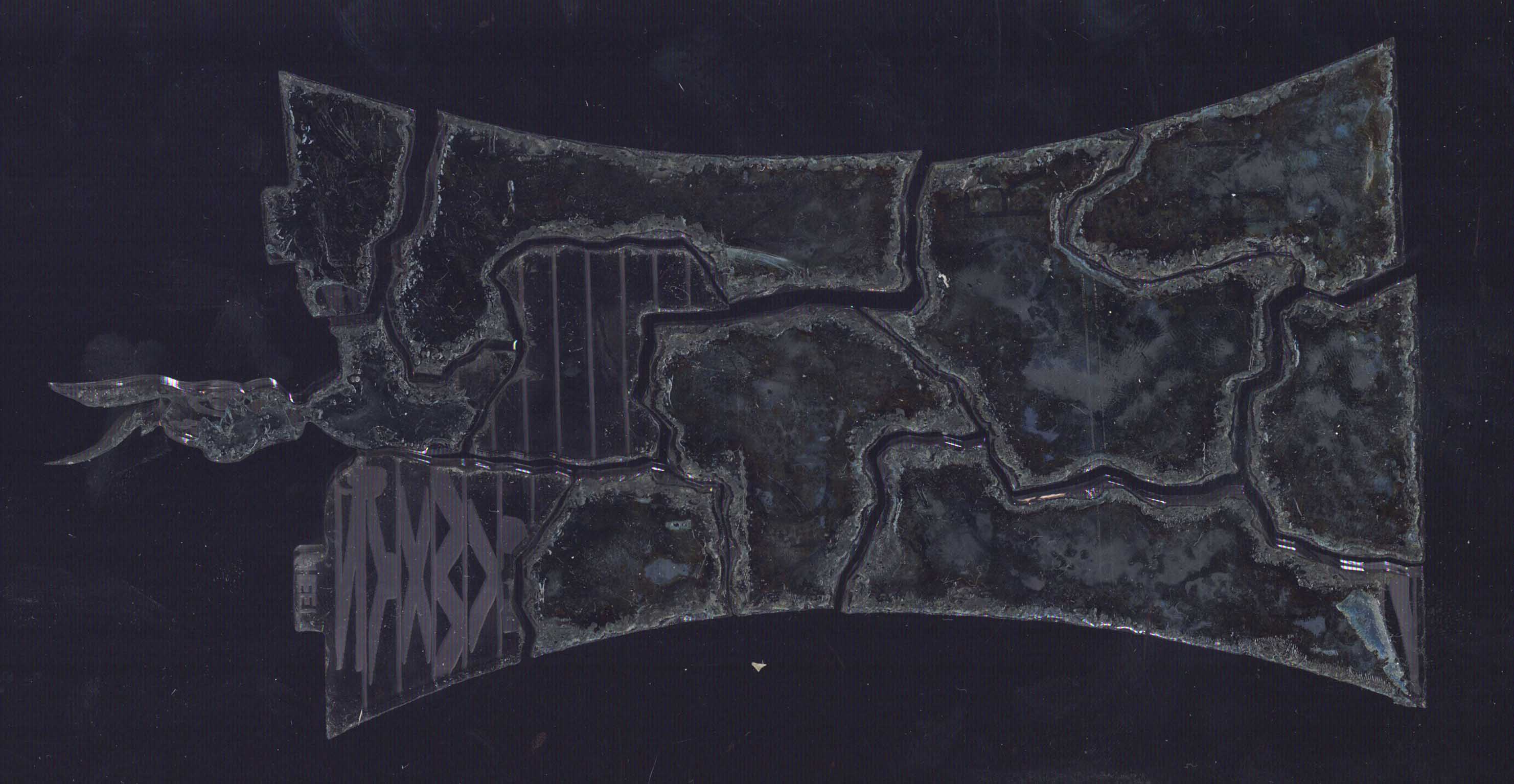
Bibliography
1- Camus, Albert. The Myth of Sisyphus, and Other Essays. A.A. Knopf, 1964.
2-Mirzoeff, N. (1998). What Is Visual Culture? In N. Mirzoeff (Ed.), The Visual Culture Reader. essay, Routledge.
3-Chtcheglov, I. (1953). Formulary for a new urbanism. Bureau Of Public Secrets. Retrieved December 14, 2022, from http://www.bopsecrets.org/SI/Chtcheglov.htm
4-Milliyet.com.tr. (2019, October 24). İstanbul'da tepki çeken görüntü! Milliyet. Retrieved February 18, 2022, from https://www.milliyet.com.tr/galeri/istanbulda-tepki-ceken-goruntu-6064180
5-İlk Atatürk Heykelini çeviren metal Paravanlar Kaldırıldı. (2018, August 19). Retrieved February 18, 2022, from https://www.cumhuriyet.com.tr/haber/ilk-ataturk-heykelini-ceviren-metal-paravanlar-kaldirildi-1060038
6-Hasol, D. (2014, September 25). Ankara'da Selçuklu Başkanlık Sarayı(!). Retrieved March 3, 2022, from http://www.doganhasol.net/ankarada-selcuklu-baskanlik-sarayi.html
7-Ak Saray, 2250 oda ile dünya şampiyonu. (2015, April 12). Retrieved January 18, 2022, from https://www.cumhuriyet.com.tr/haber/ak-saray-2250-oda-ile-dunya-sampiyonu-252697
8-Kesler, M. (2021, June 19). Sanat Değil Heykel Komedisi! Yapanlar Bile Sonuçtan Mutsuz... Hürriyet Newspaper. Retrieved December 16, 2021, from https://www.hurriyet.com.tr/gundem/sanat-degil-heykel-komedisi-yapanlar-bile-sonuctan-mutsuz-41835209
9-Leylak, A. (2017, September 13). Erdoğan Heykeli hakkında yeni gelişme. Egenin Sesi. Retrieved January 27, 2022, from http://egeninsesi.com/haber/188048-erdogan-heykeli-hakkinda-yeni-gelisme
10-Greenwood, J. (2018, July 25). How would people behave in milgram's experiment today? Behavioral Scientist. Retrieved January 10, 2022, from https://behavioralscientist.org/how-would-people-behave-in-milgrams-experiment-today/
11-Dirse Han oğlu boğaç han. Türk Destanları. (n.d.). Retrieved March 24, 2022, from https://destanlar.blogspot.com/2009/02/dirse-han-oglu-bogac-han.html
12-Bate, D. (2009). Photography: The key concepts. Berg Publishers.
13-Steyerl, H. (2011, April). In free fall: A thought experiment on Vertical Perspective . E-flux Journal #24 . Retrieved January 19, 2022, from https://www.e-flux.com/journal/24/67860/in-free-fall-a-thought-experiment-on-vertical-perspective/
14-Various phone conversations with production companies
15-Published by David Weiner An entertainment industry mainstay, Weiner, P. by D., Weiner, D., mainstay, A. entertainment industry, & View all posts by David Weiner. (2020, February 27). S*T*A*R team: A beloved 'Star wars' knockoff's origin & rebirth. IT CAME FROM... Retrieved March 5, 2022, from https://itcamefromblog.com/2018/06/05/star-team-a-beloved-star-wars-knockoffs-origin-rebirth/
16-Ed’s Retro Geek Out. (2021, April 22). Star wars knock off toys, rip offs, bootlegs & lawsuits - toy history #27. YouTube. Retrieved March 12, 2022, from https://www.youtube.com/watch?v=gN0KI6YrxE0&t=555s
17-Ankara Kedisi Misket öğrenecek. BeyazGazete. (n.d.). Retrieved February 5, 2022, from https://beyazgazete.com/video/anahaber/beyaz-tv-81/2012/4/9/ankara-kedisi-misket-ogrenecek-265272.html
18-Lee, D., & Wysaski , J. (2019, February 22). The internet's best fake toys are going in a fake museum. The Verge. Retrieved December 17, 2022, from https://www.theverge.com/2019/2/22/18232343/obvious-plant-museum-of-toys-bootleg-action-figures
19-Juzwiak, R. (2018, November 23). 'bootleg toys' are their own kind of collectibles. The New York Times. Retrieved February 25, 2022, from https://www.nytimes.com/2018/11/23/style/bootleg-toys-action-figures.html
20-Allahyari, M. (n.d.). MATERIAL SPECULATION: ISIS (2015-2016). Morehshin.com. Retrieved December 5, 2022, from http://www.morehshin.com/material-speculation-isis/
21-Gander, R. (2002). Loose associations and other lectures. Onestar Press.
22-Shafranyosh, O. (2018). Counterculture as a challenge for 20th century and it’s influence on modern society. In VÝZVY A RIZIKÁ SPOLOČNOSTI V 21. STOROČÍ. essay.
23-Husted, B. W. (1999). Wealth, culture, and corruption. Journal of International Business Studies, 30(2), 339–359. https://doi.org/10.1057/palgrave.jibs.8490073
24-Sontag, S. (1964). Notes On "Camp".
25-Steyerl, H. (2010, December). Politics of art: Contemporary art and the transition to Post-Democracy . E-flux Journal #21. Retrieved March 6, 2022, from https://www.e-flux.com/journal/21/67696/politics-of-art-contemporary-art-and-the-transition-to-post-democracy/
26-Hofstede, G. H. (1997). Cultures and organizations software of the mind. McGraw-Hill.
27-Eyuboglu, G. (2018). Theme Park as a Socio-Cultural and Architectural Program: A Critical Review of Ankapark, Ankara.
28-Botterill, J.(1997) “The "Fairest" Of The Fairs: A History Of Fairs, Amusement Parks, And Theme Parks,”